Abstract
The complement system consists of both plasma and membrane proteins. The former influence the inflammatory response, immune modulation, and host defense. The latter are complement receptors, which mediate the cellular effects of complement activation, and regulatory proteins, which protect host cells from complement-mediated injury. Complement activation occurs via either the classical or the alternative pathway, which converge at the level of C3 and share a sequence of terminal components. Four aspects of the complement cascade are critical to its function and regulation: (i) activation of the classical pathway, (ii) activation of the alternative pathway, (iii) C3 convertase formation and C3 deposition, and (iv) membrane attack complex assembly and insertion. In general, mechanisms evolved by pathogenic microbes to resist the effects of complement are targeted to these four steps. Because individual complement proteins subserve unique functional activities and are activated in a sequential manner, complement deficiency states are associated with predictable defects in complement-dependent functions. These deficiency states can be grouped by which of the above four mechanisms they disrupt. They are distinguished by unique epidemiologic, clinical, and microbiologic features and are most prevalent in patients with certain rheumatologic and infectious diseases. Ethnic background and the incidence of infection are important cofactors determining this prevalence. Although complement undoubtedly plays a role in host defense against many microbial pathogens, it appears most important in protection against encapsulated bacteria, especially Neisseria meningitidis but also Streptococcus pneumoniae, Haemophilus influenzae, and, to a lesser extent, Neisseria gonorrhoeae. The availability of effective polysaccharide vaccines and antibiotics provides an immunologic and chemotherapeutic rationale for preventing and treating infection in patients with these deficiencies.
Full text
PDF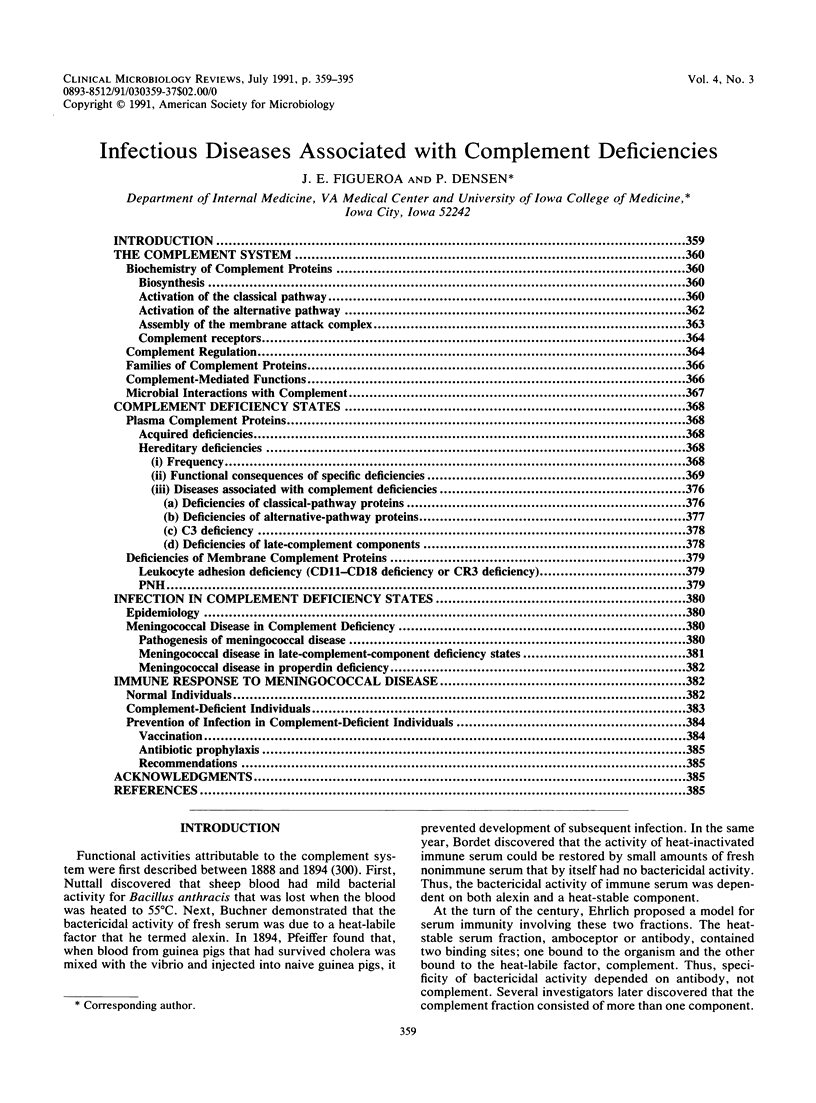

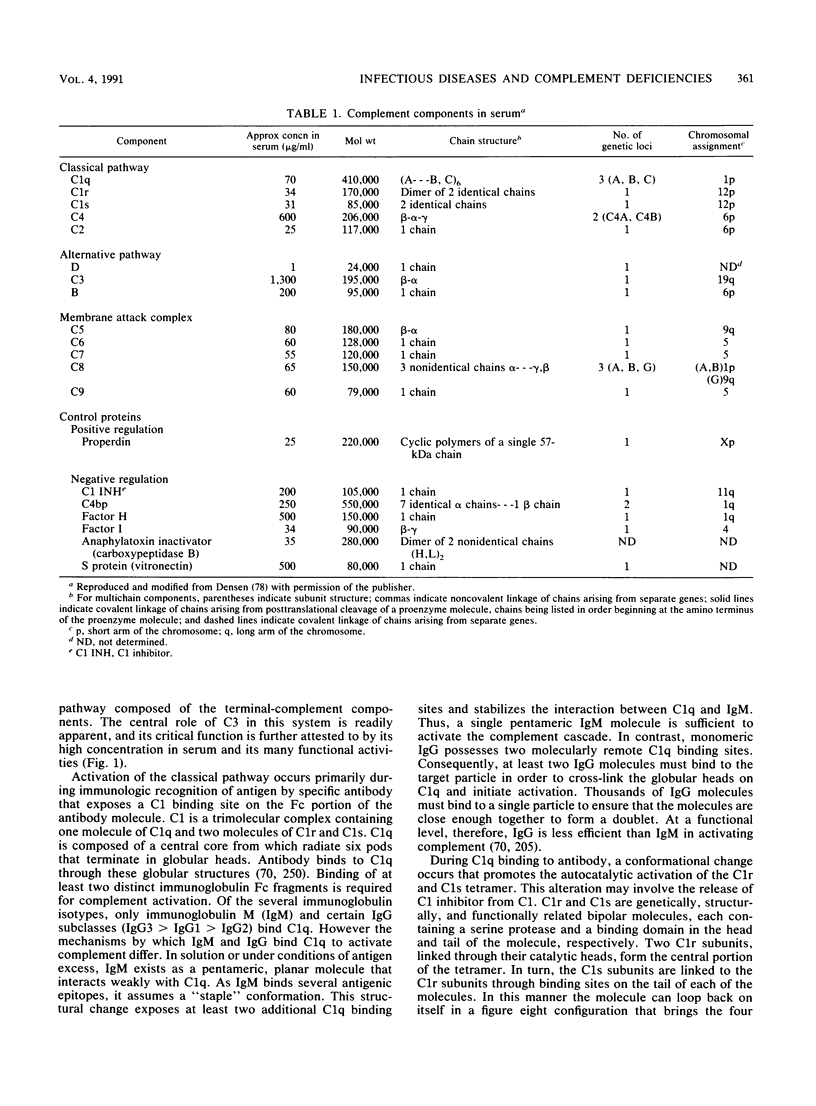
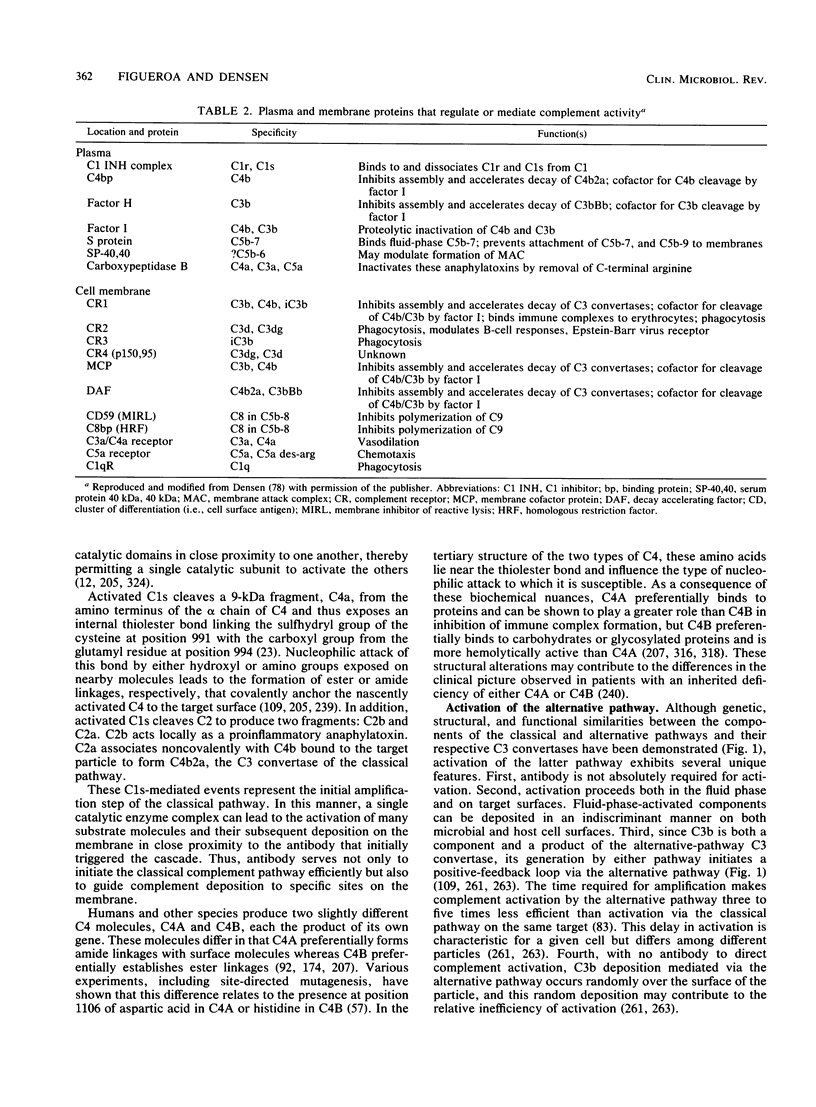
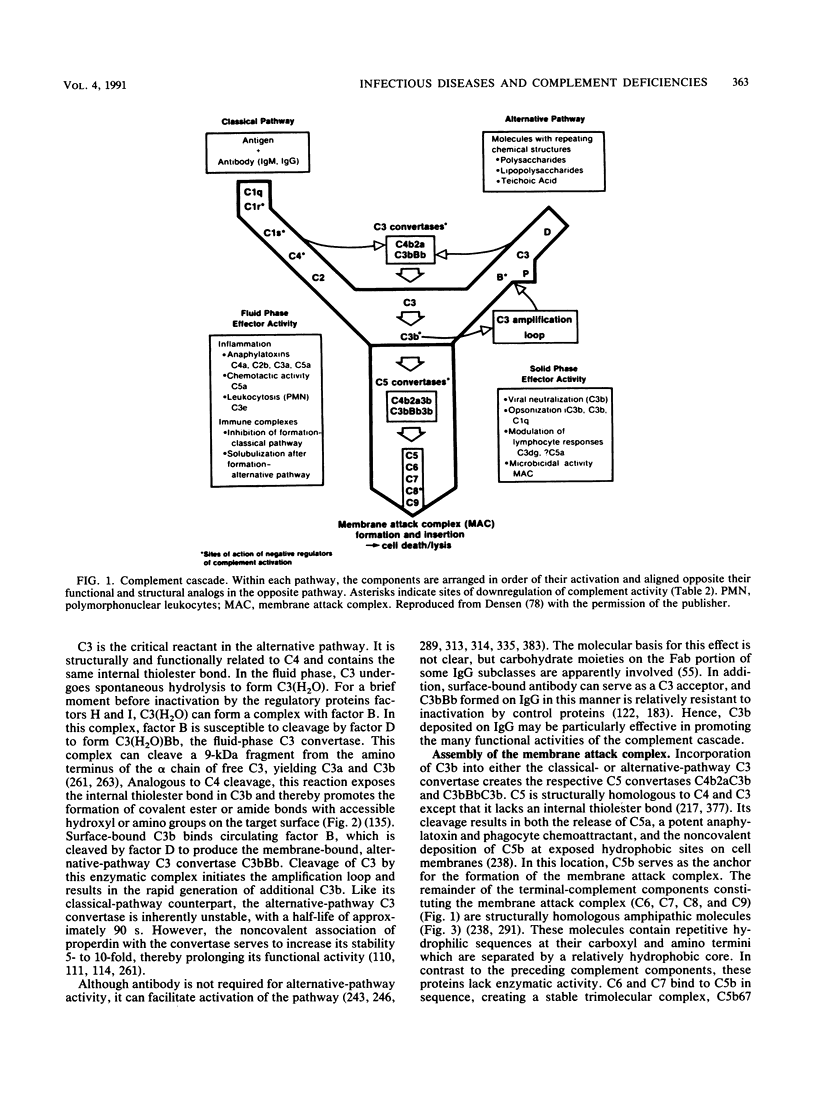
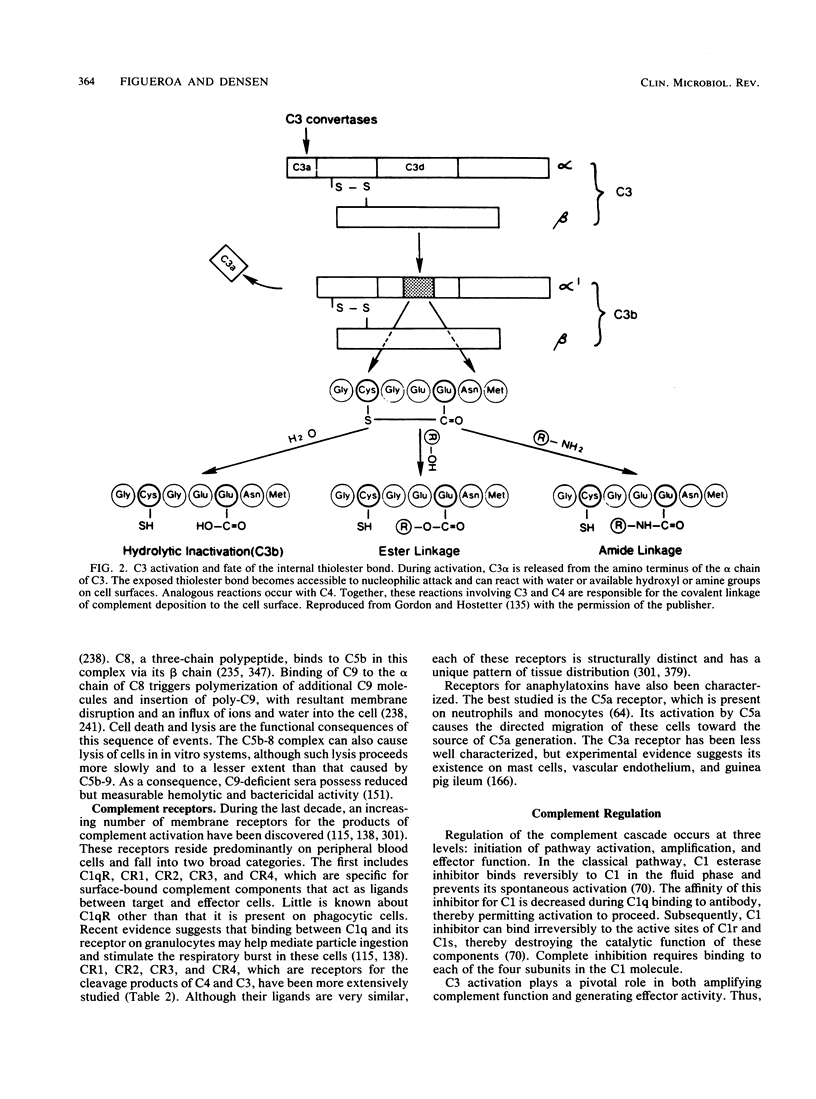
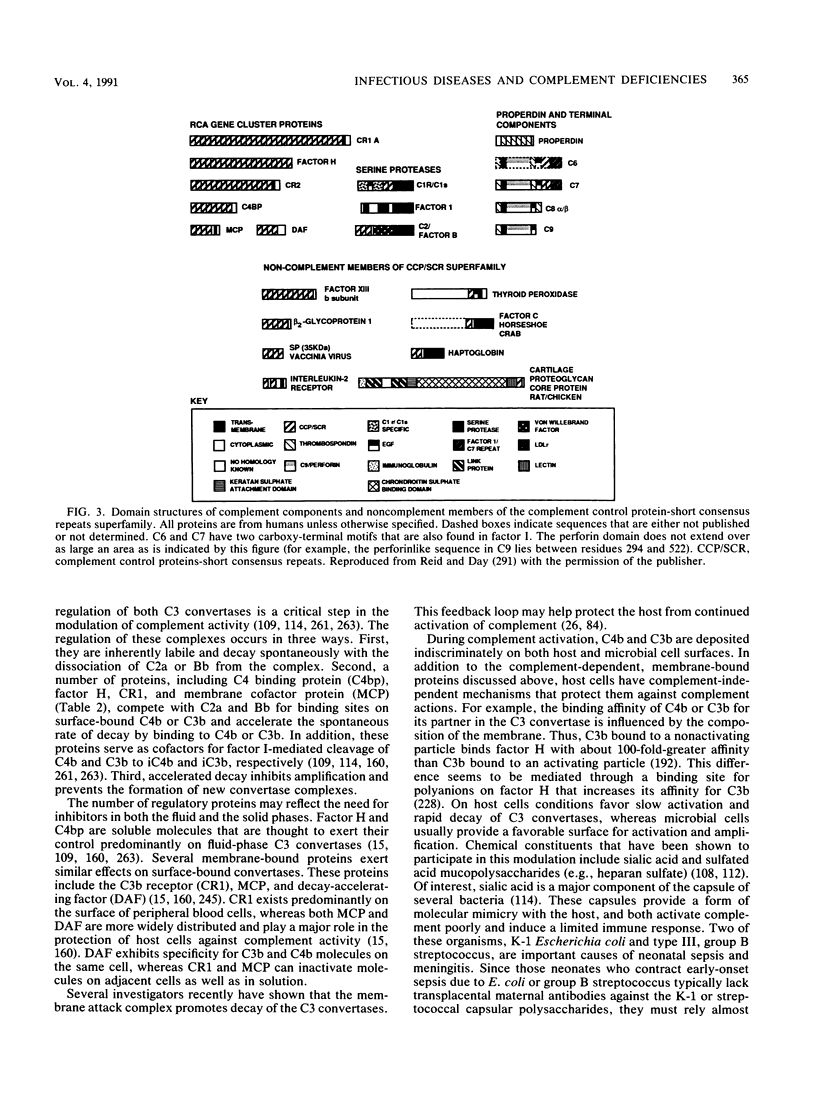

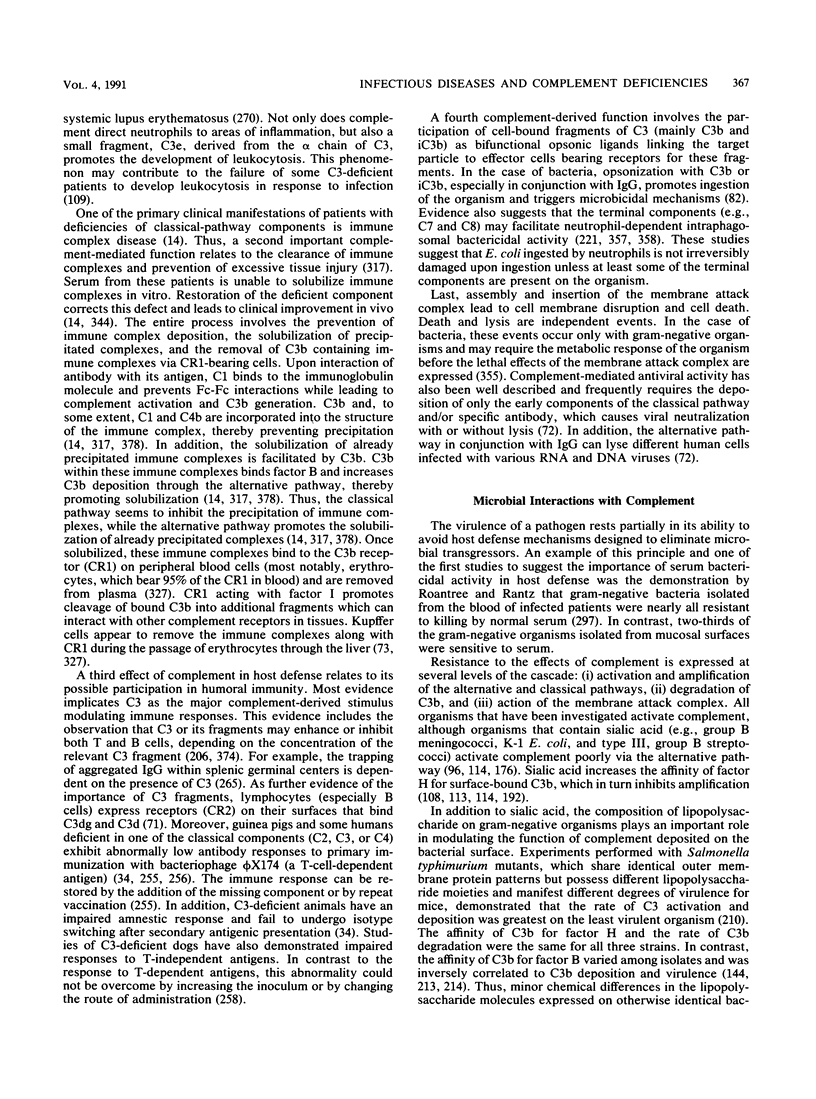
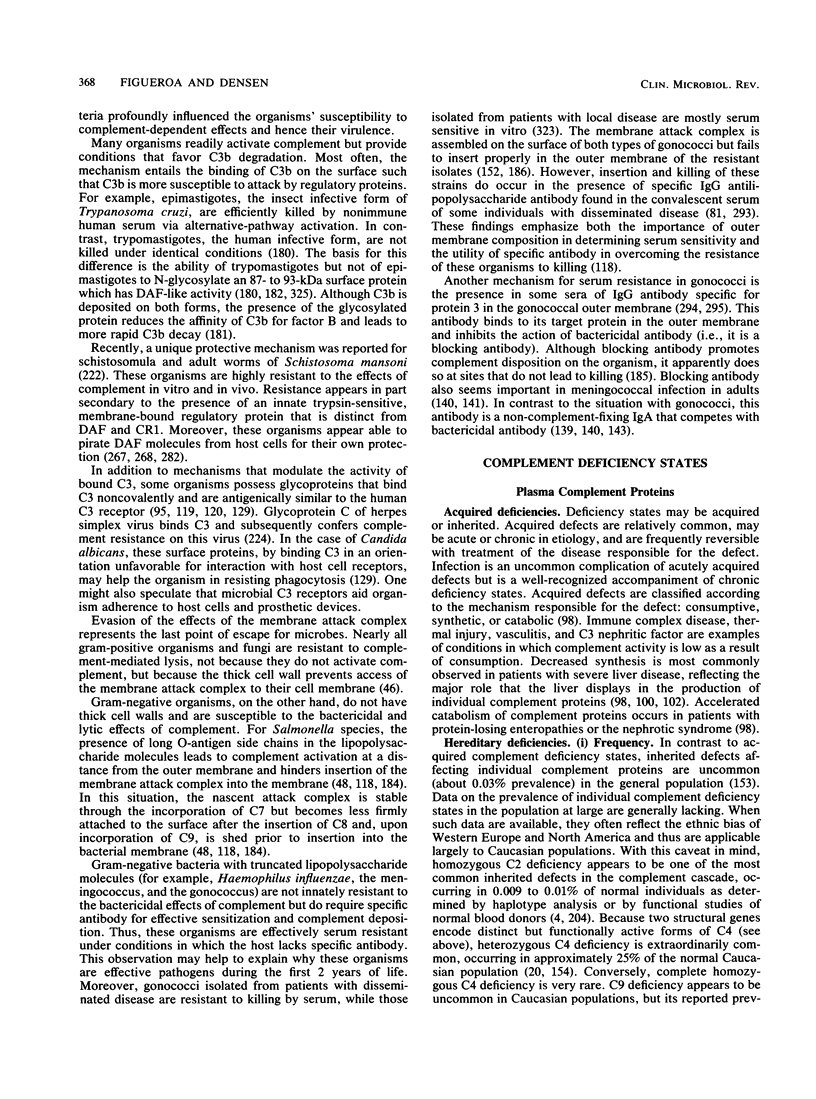
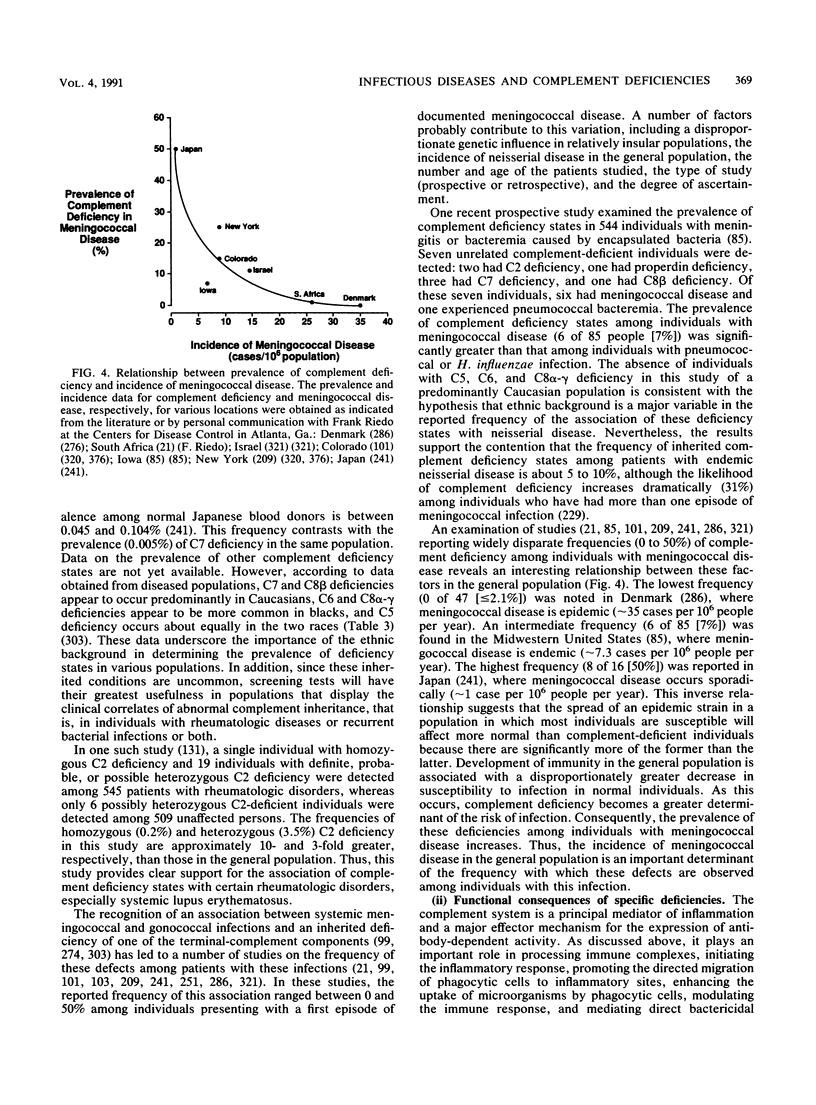
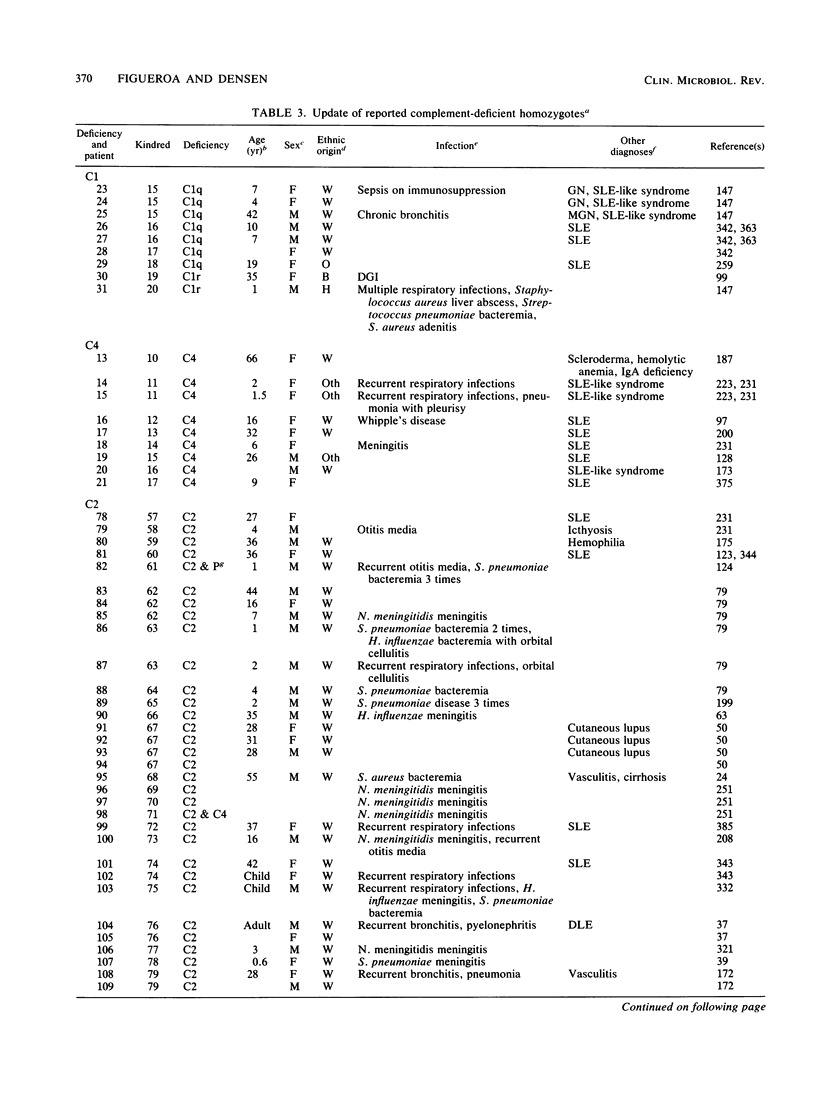
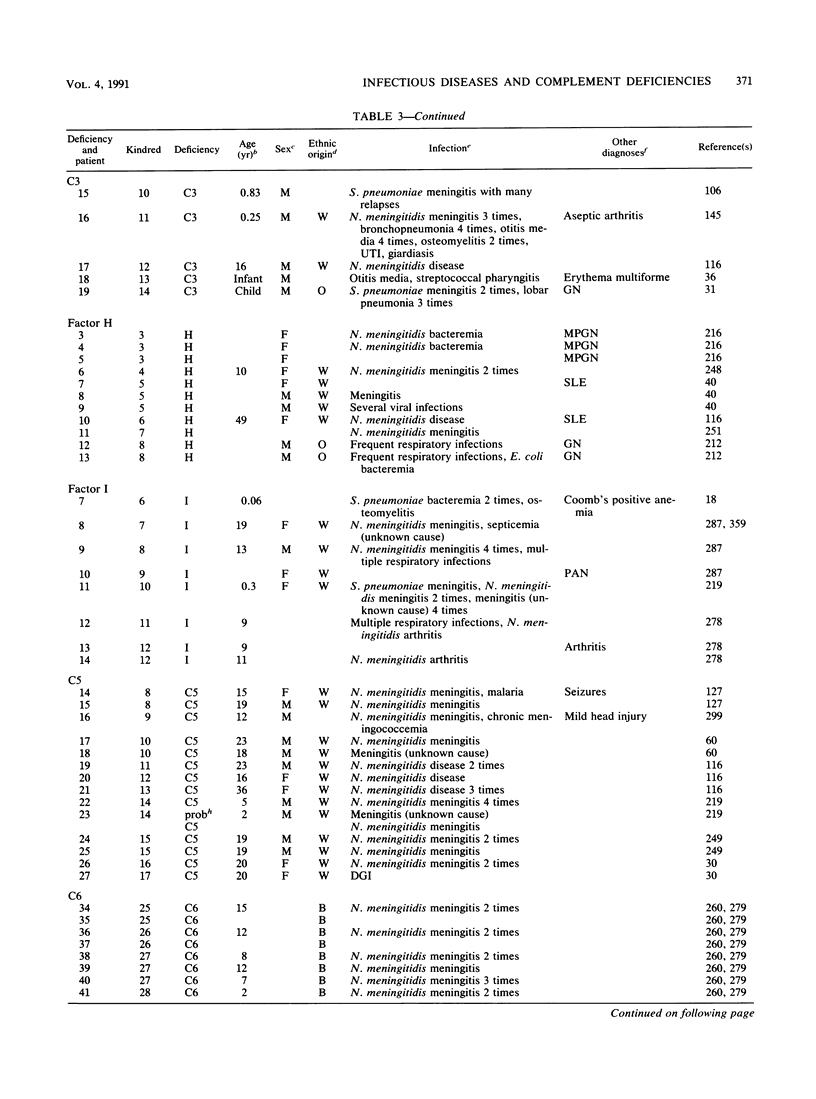
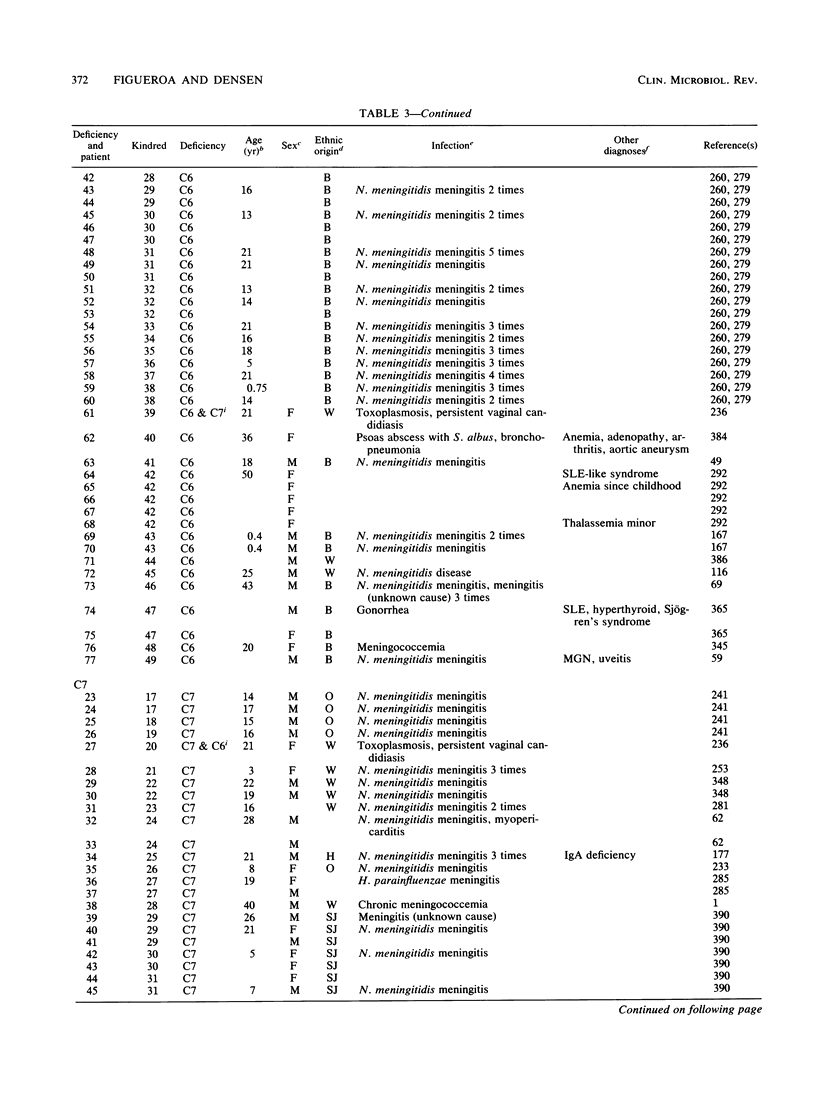
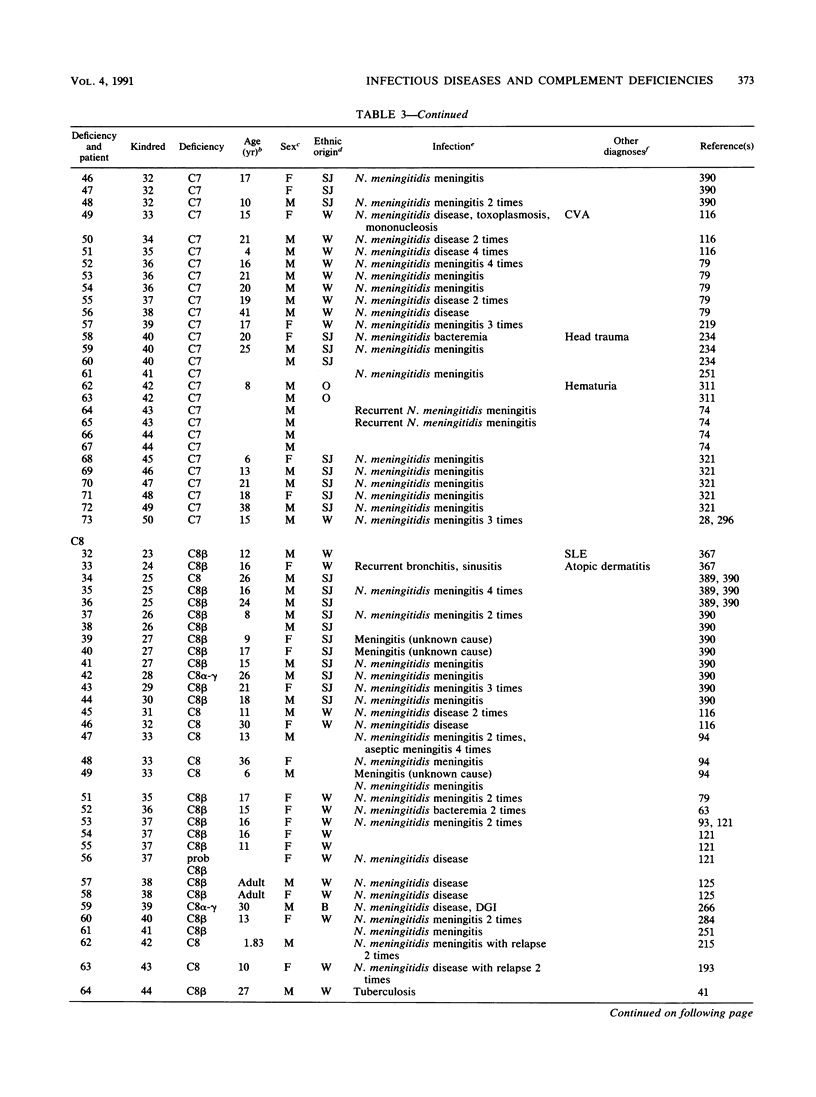
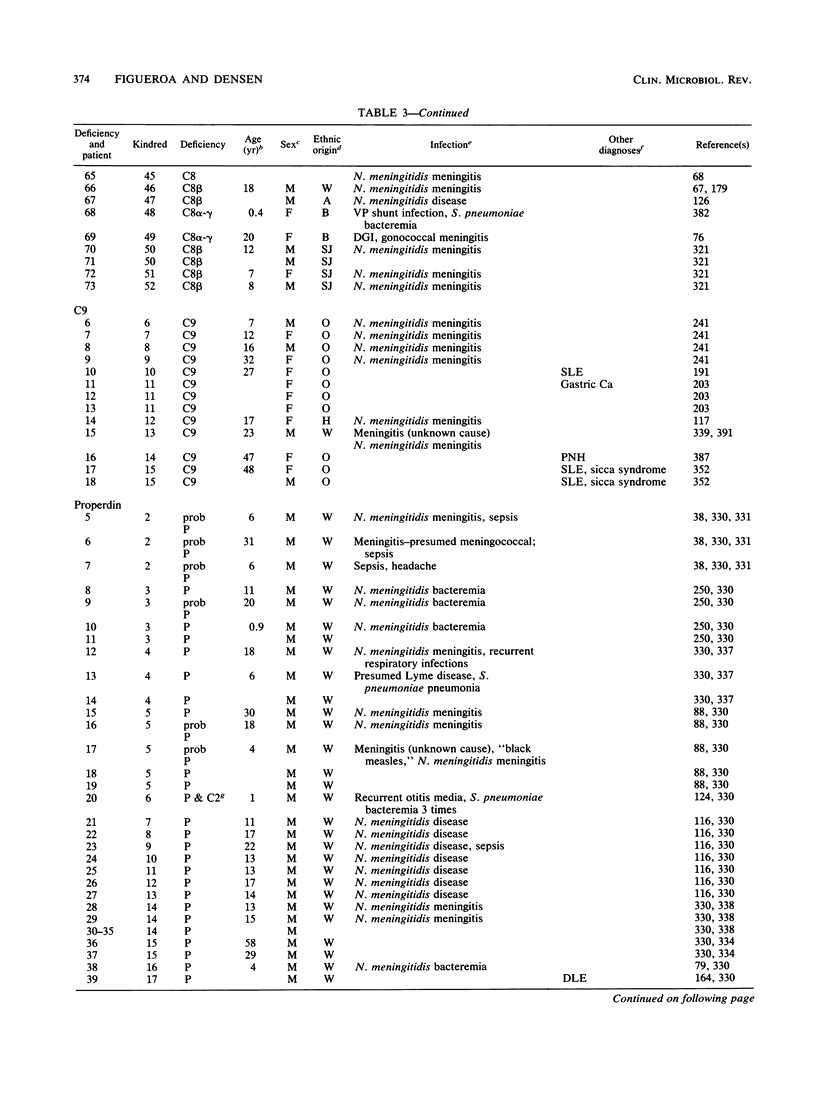

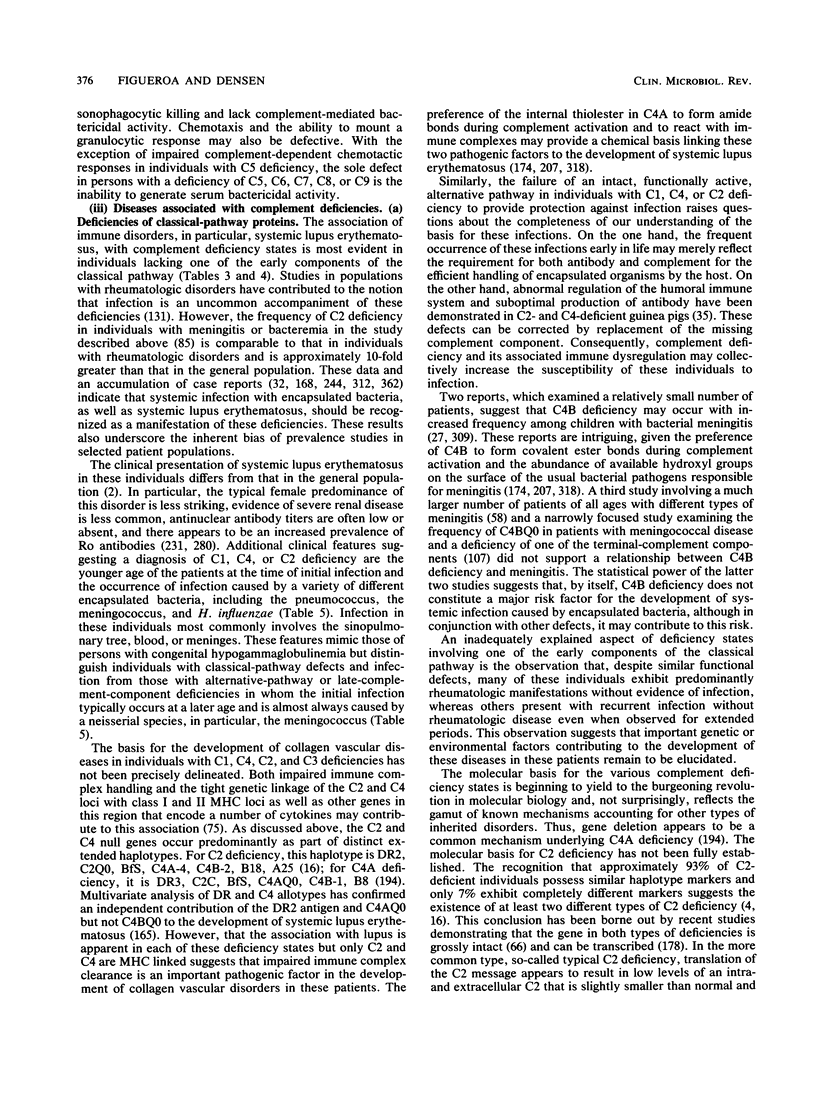
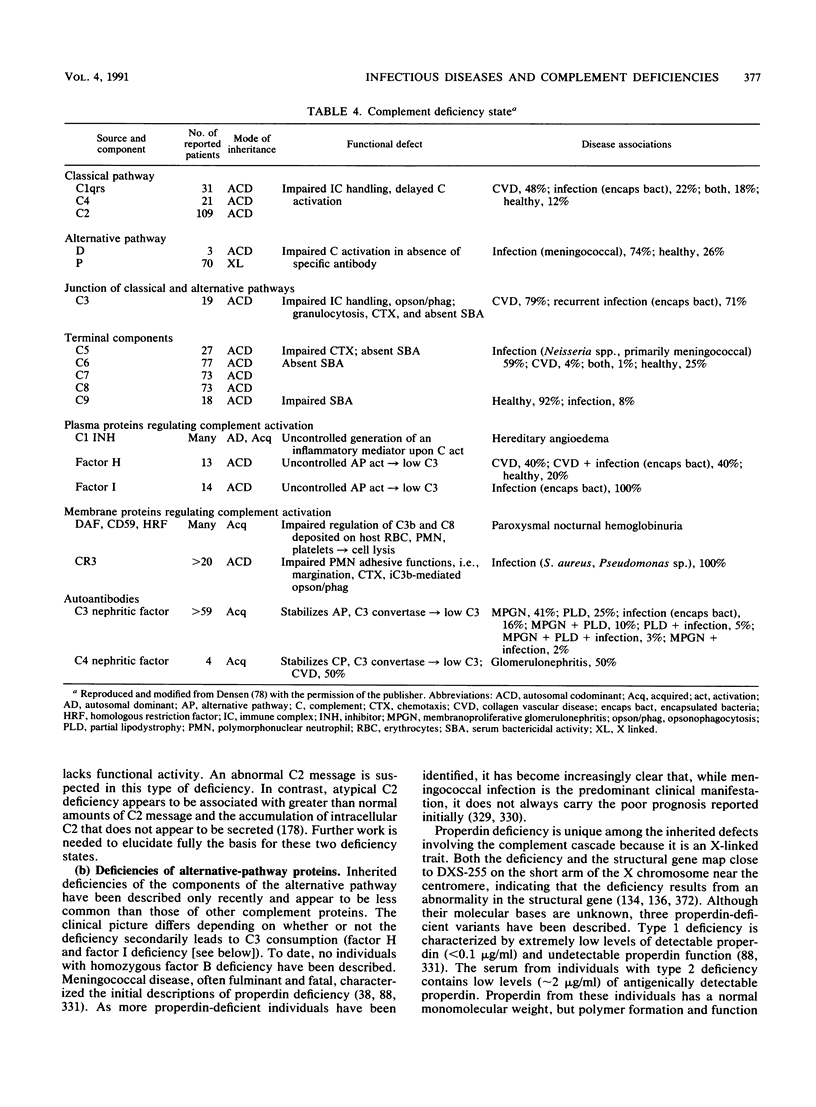
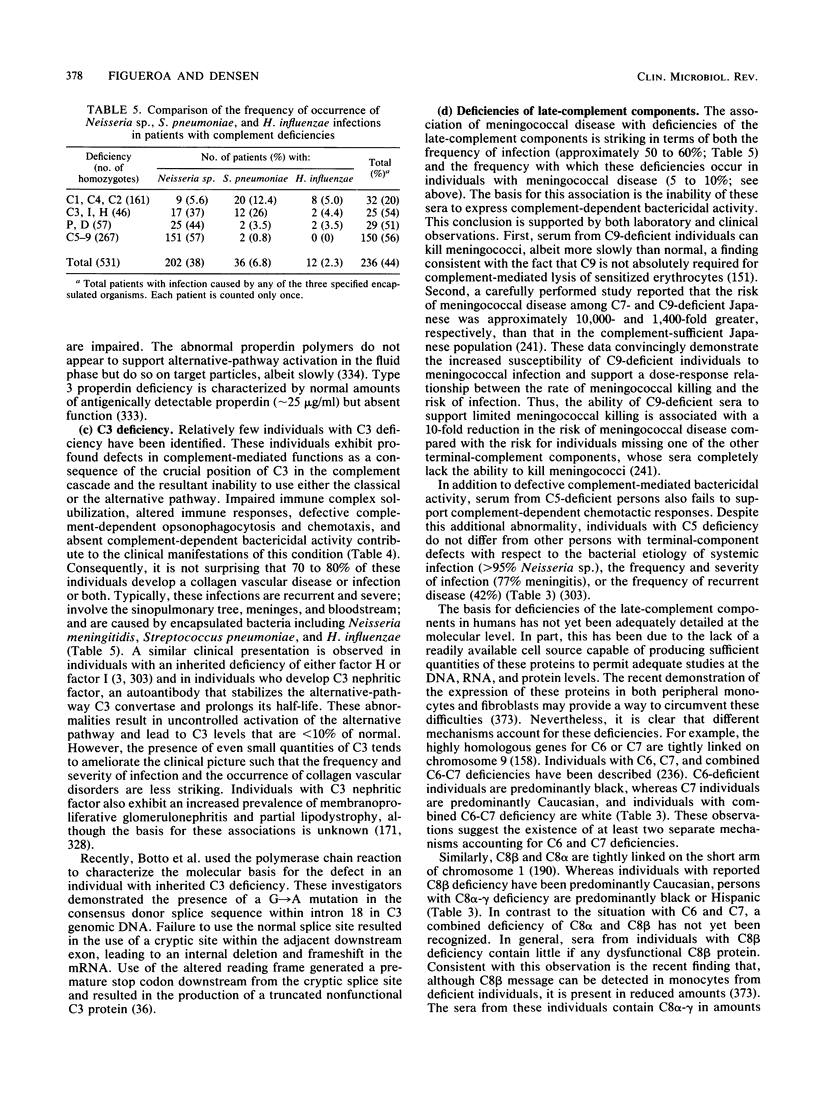
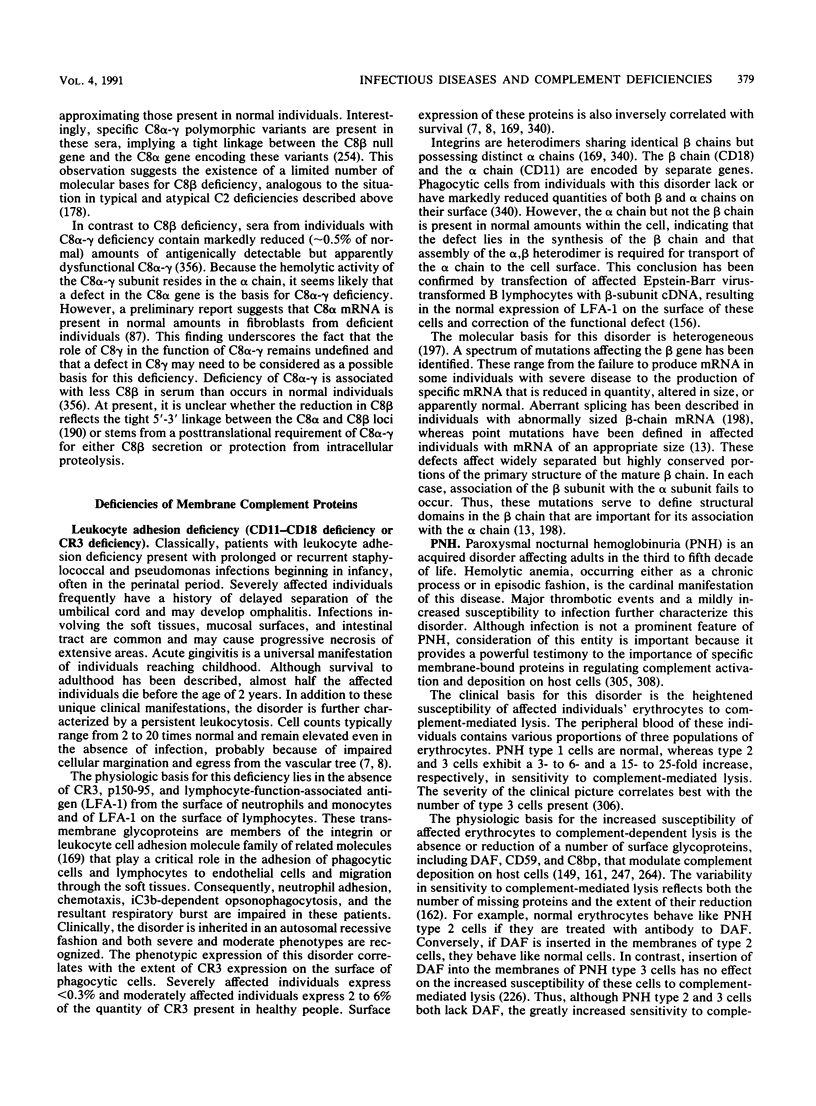
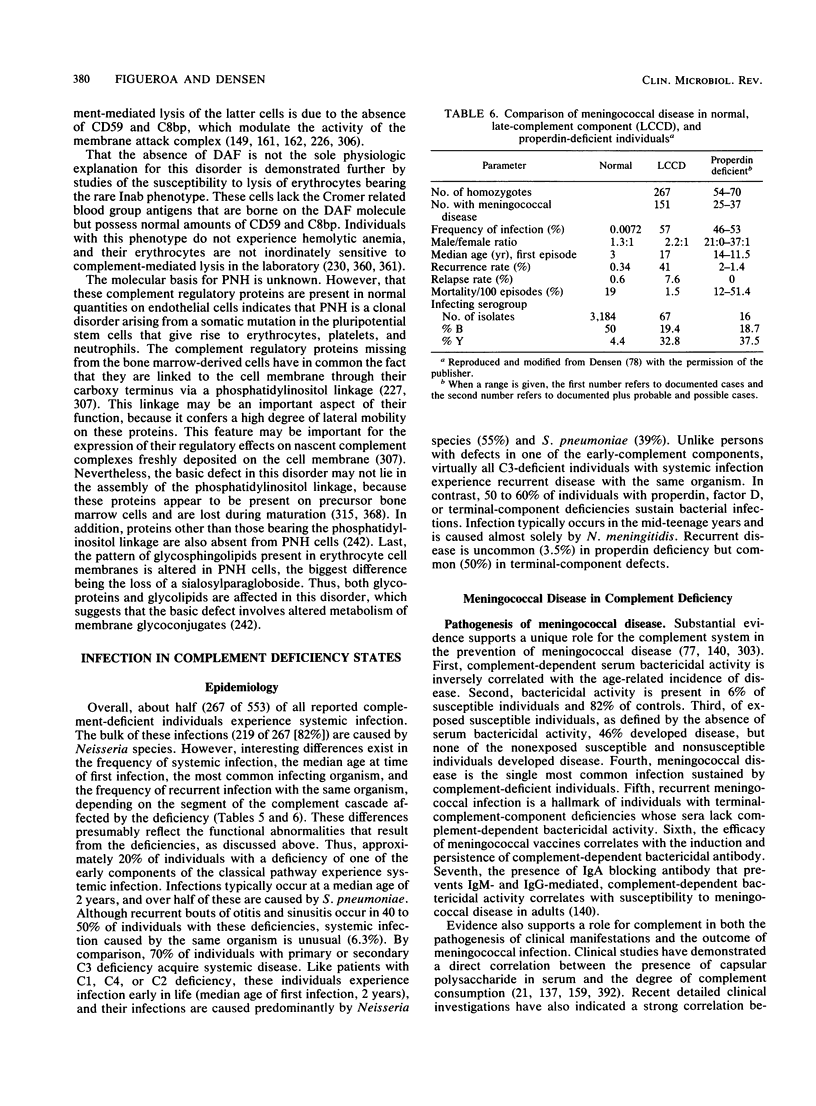
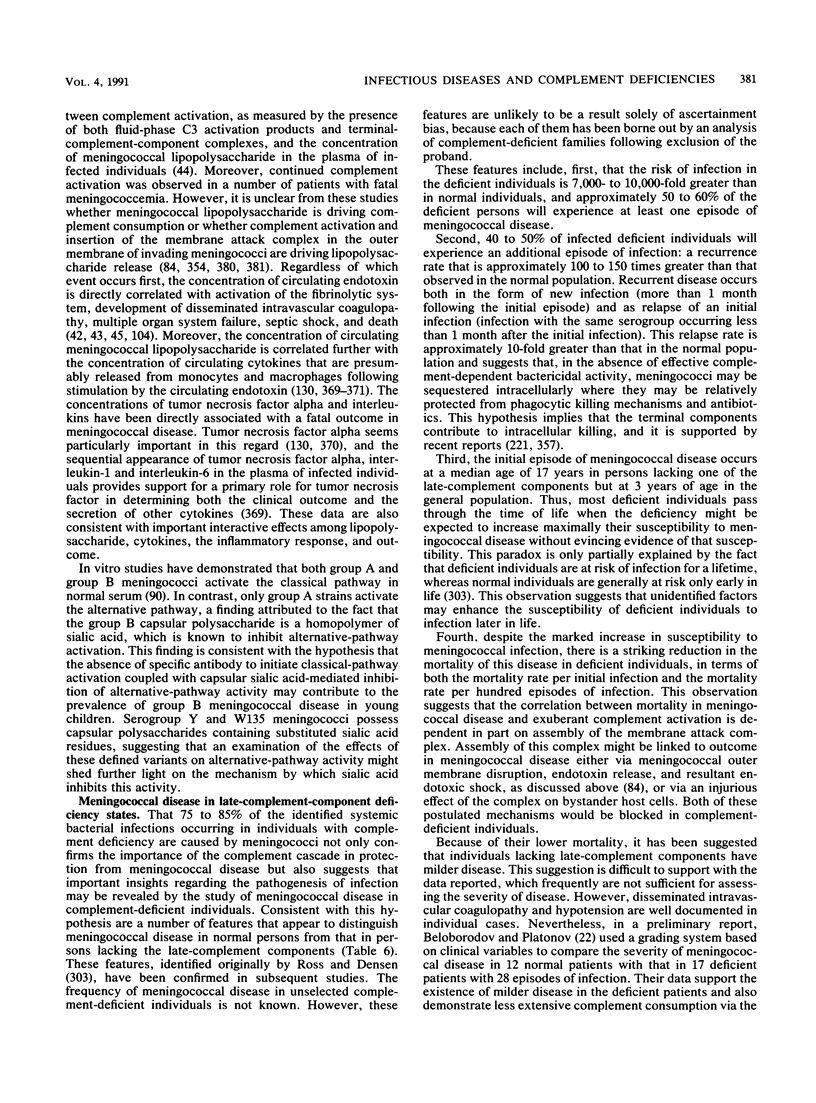
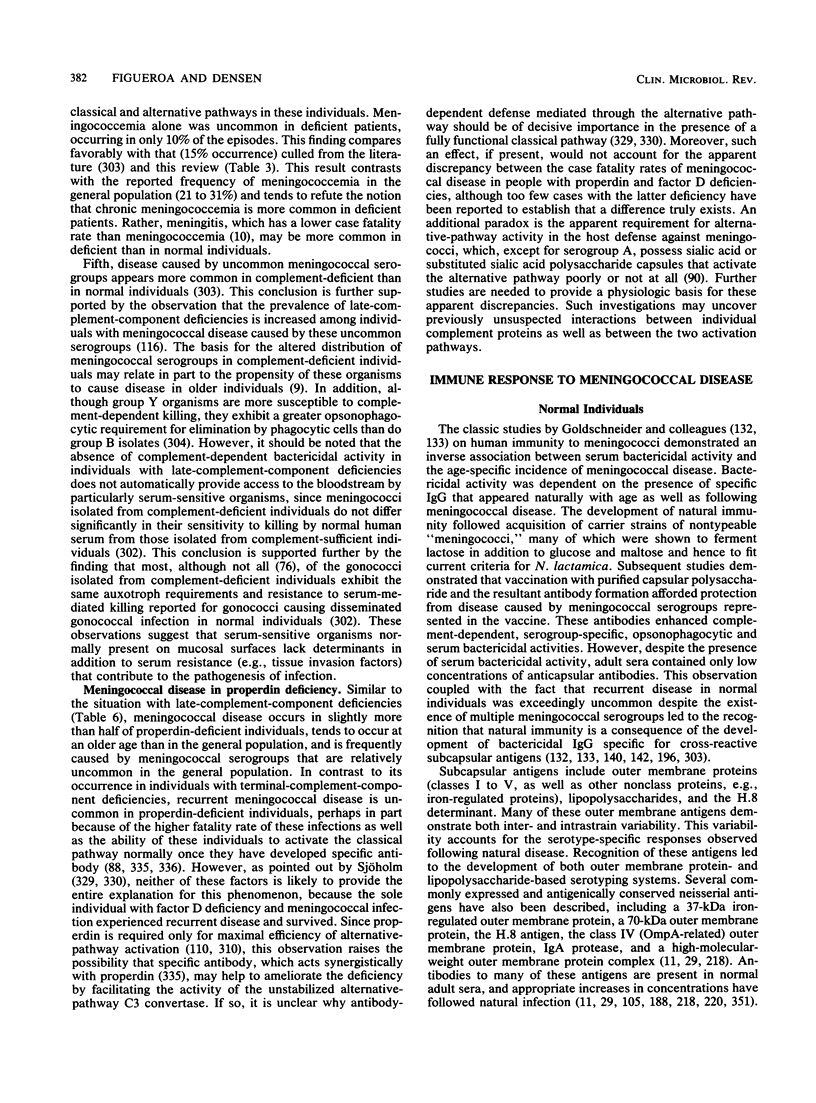
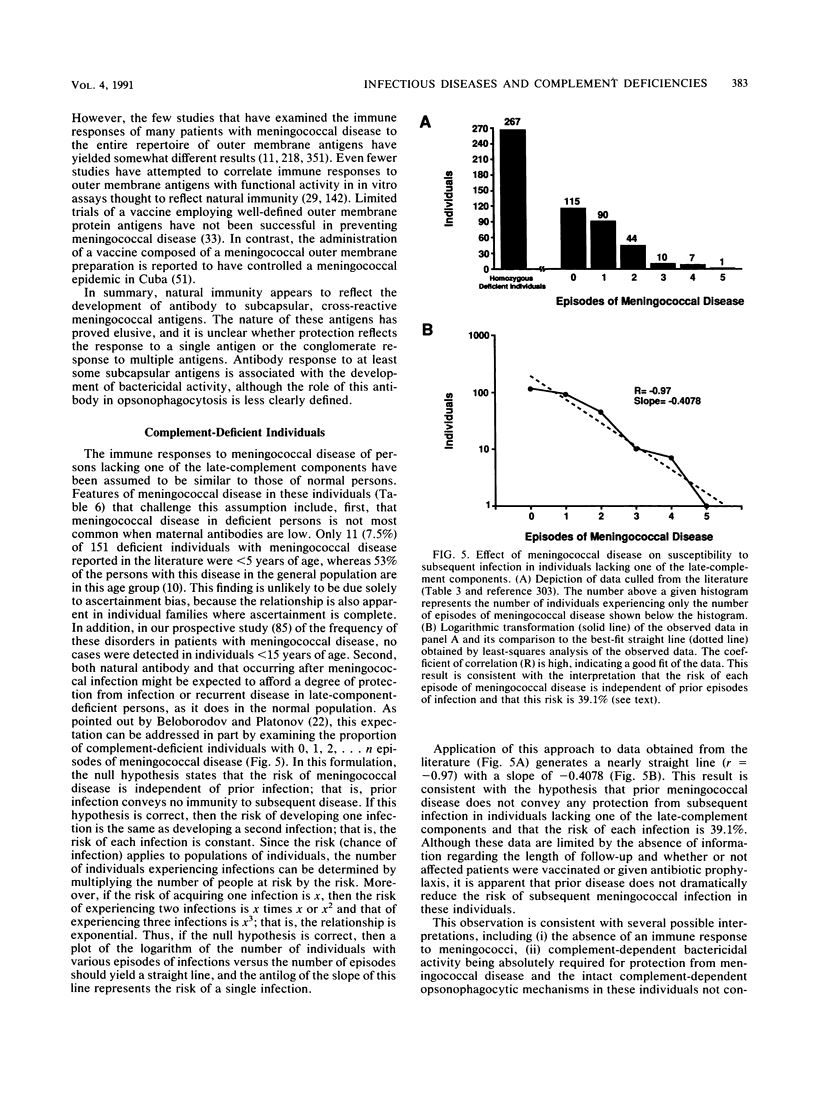
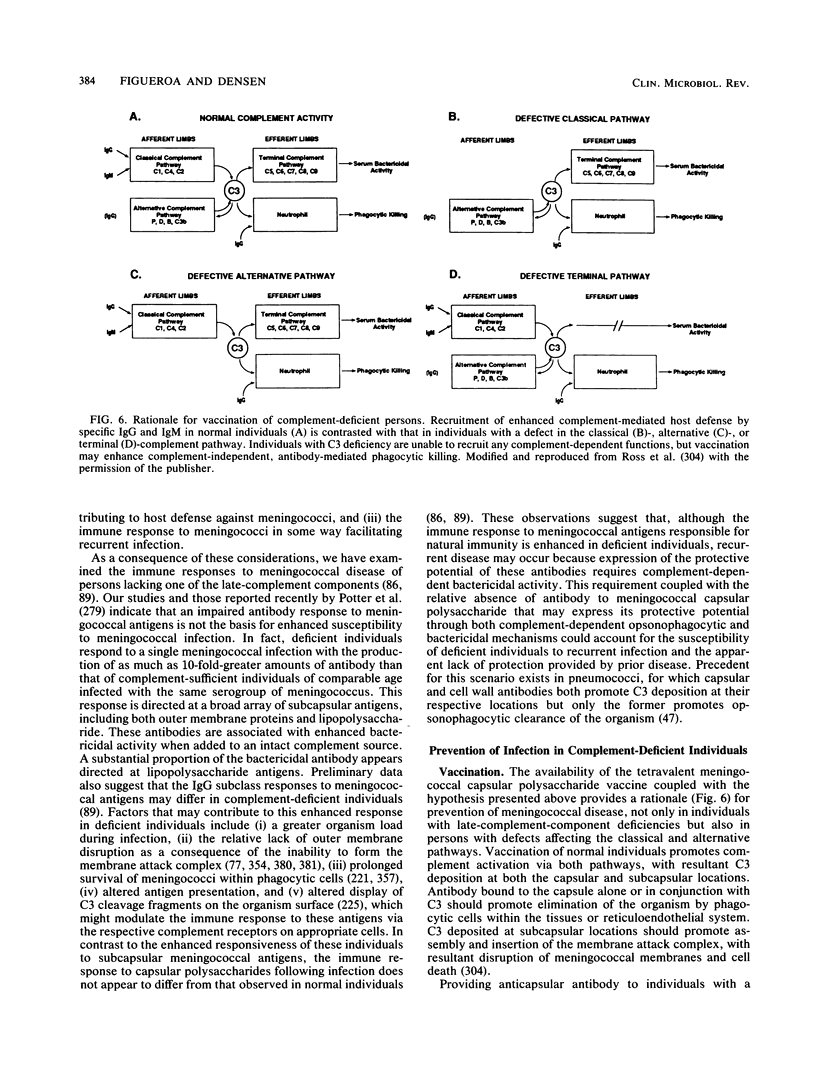
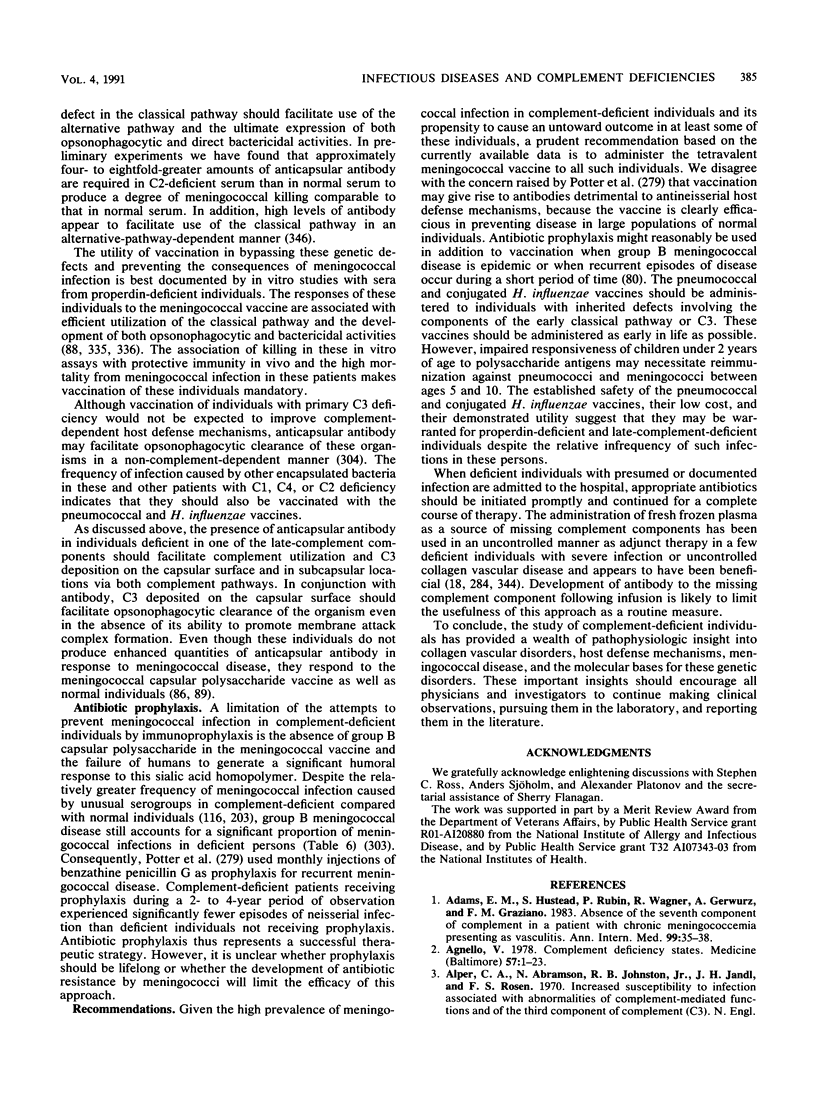
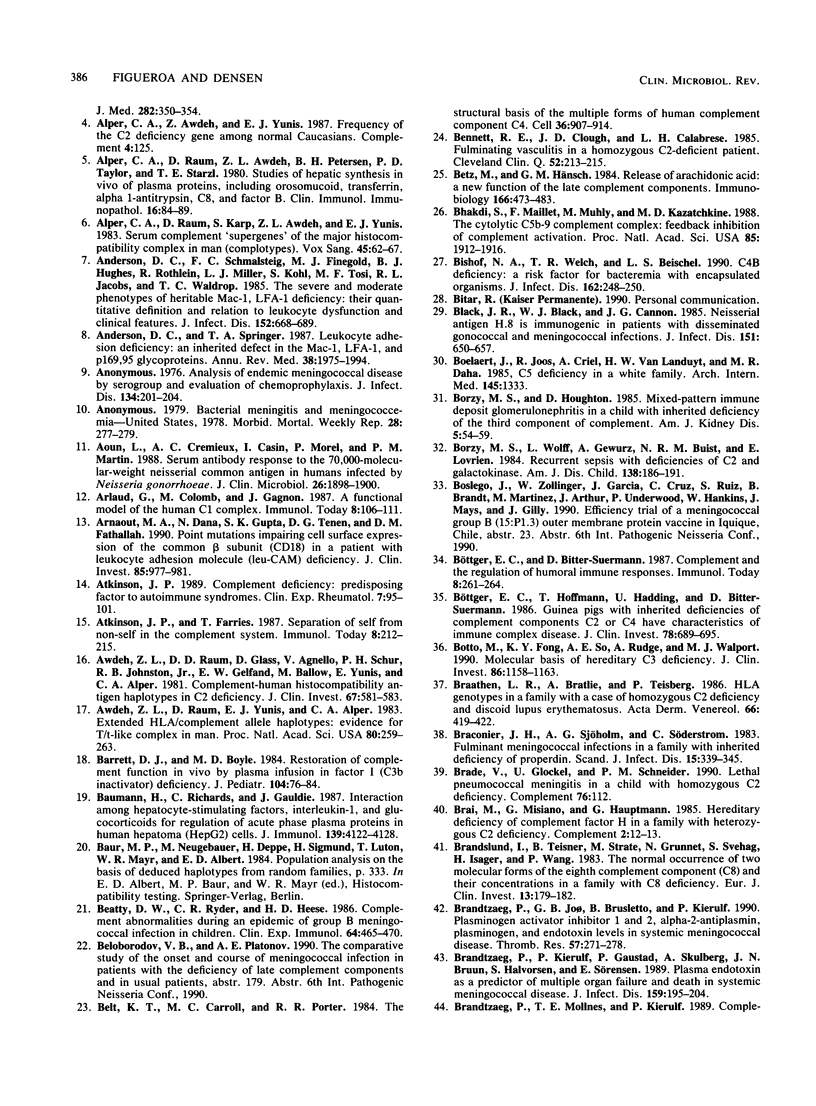

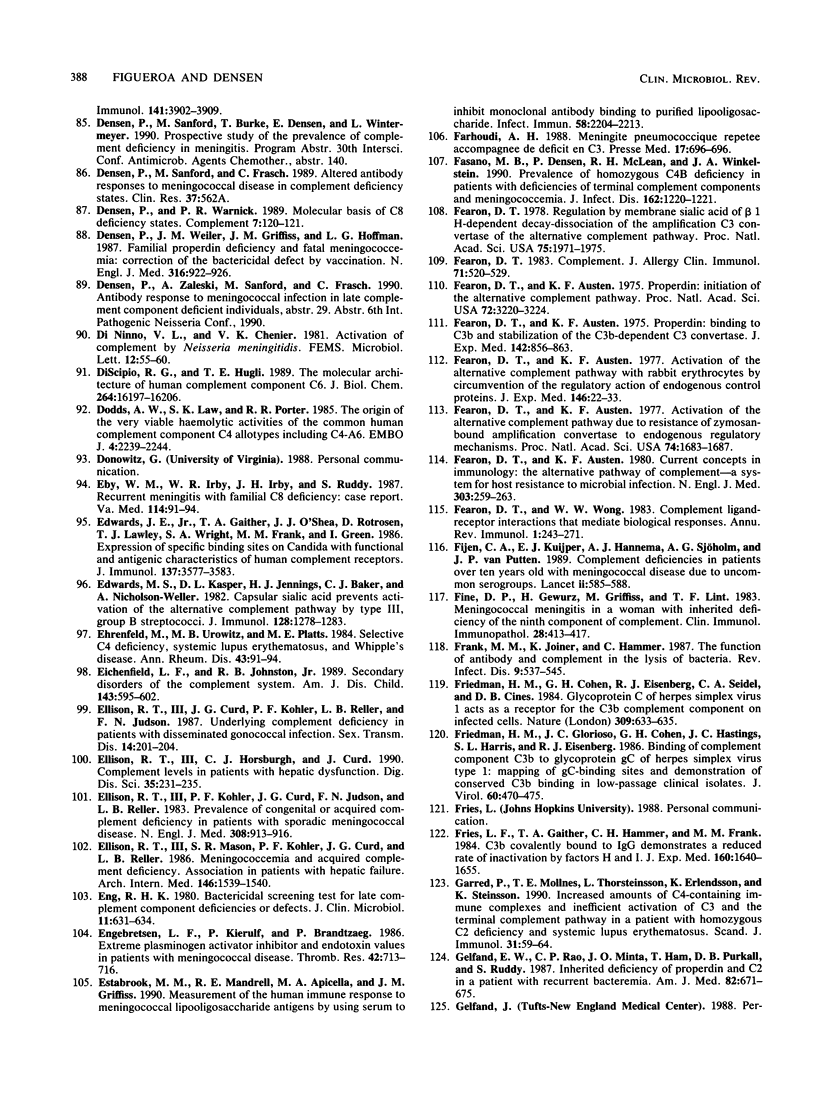
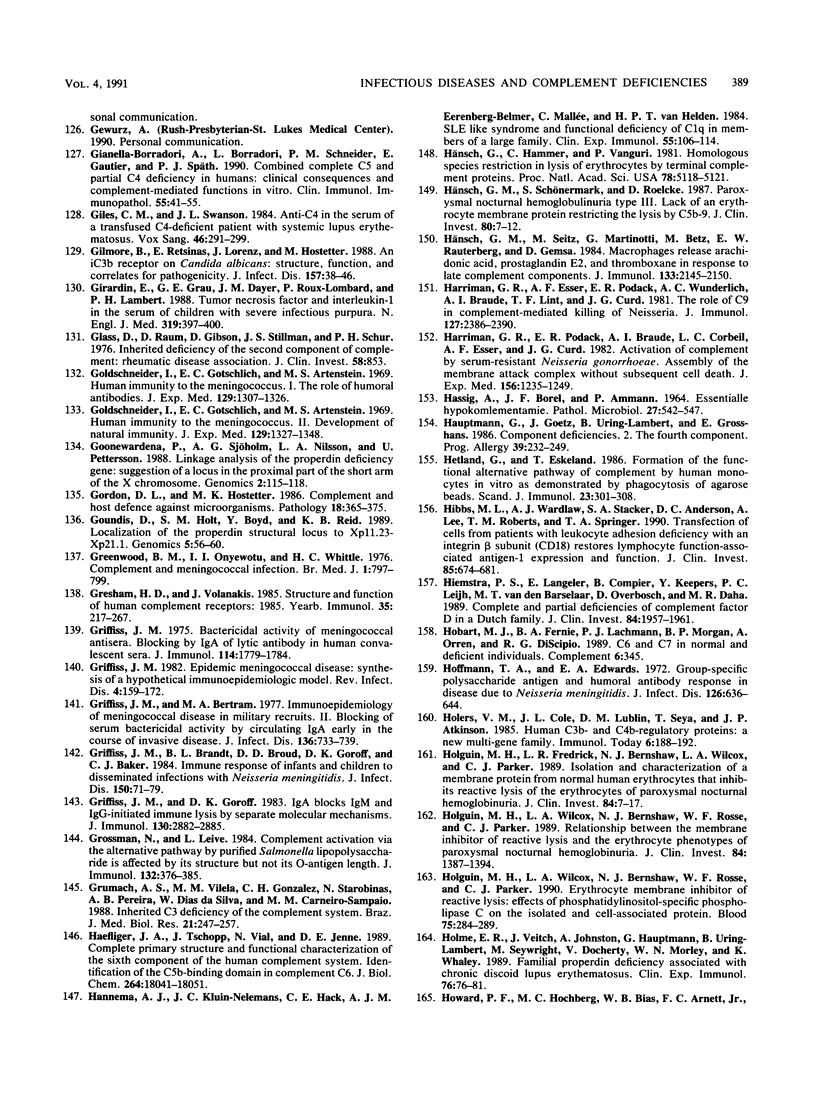
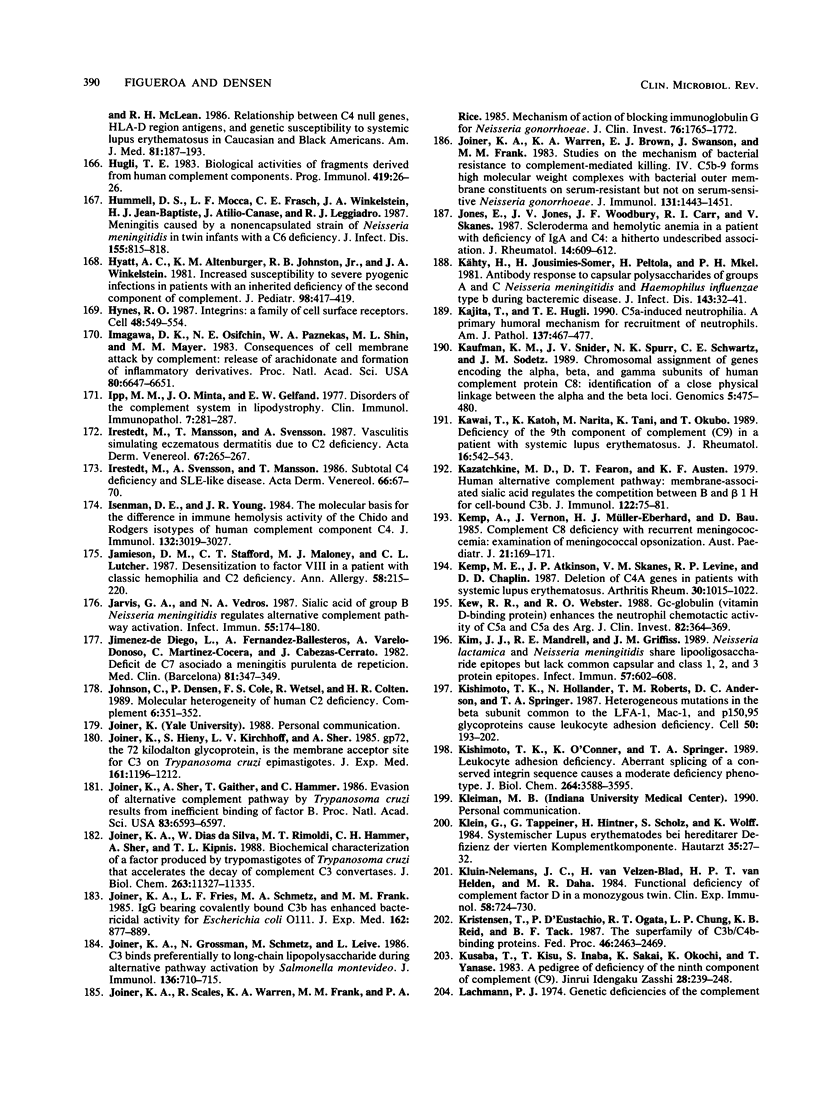
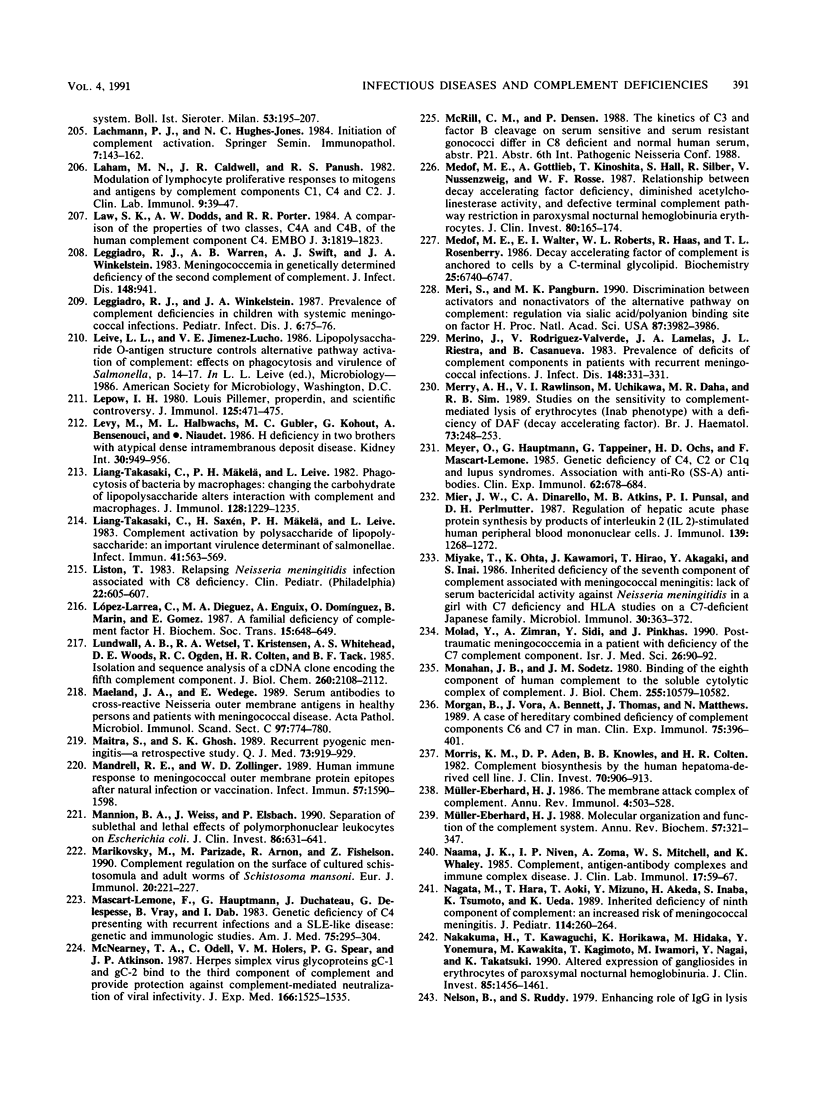
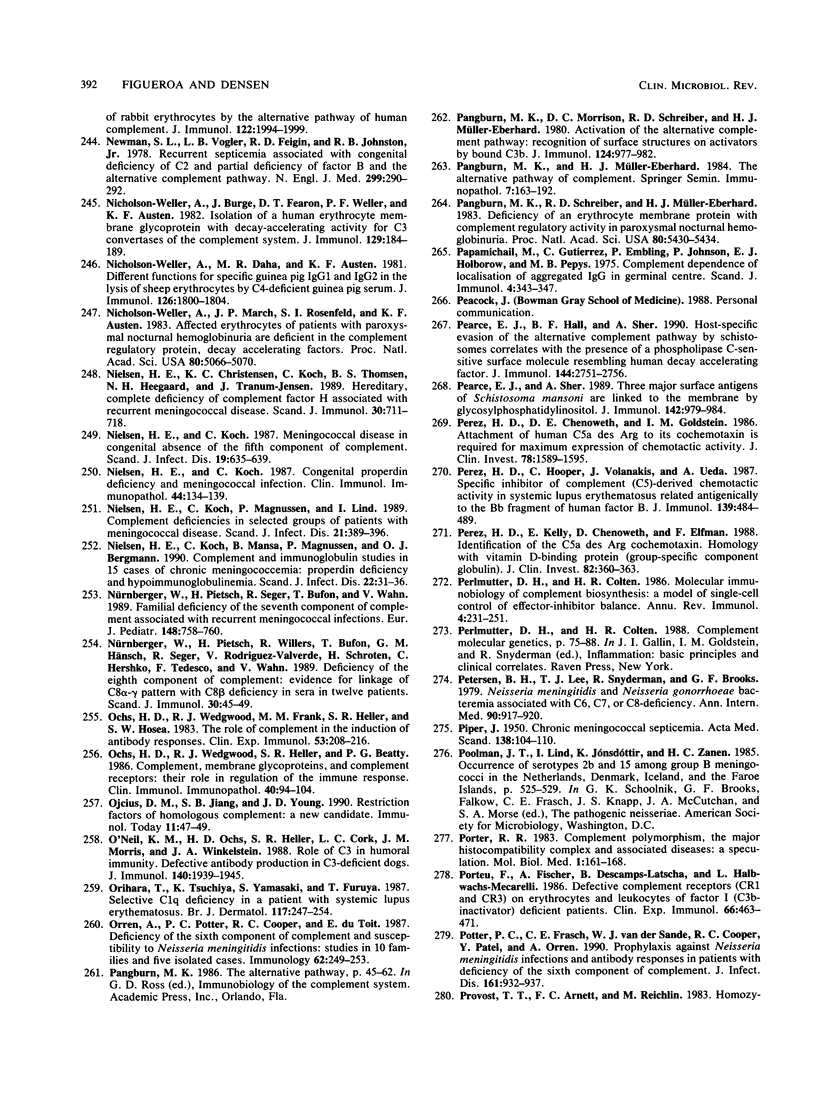
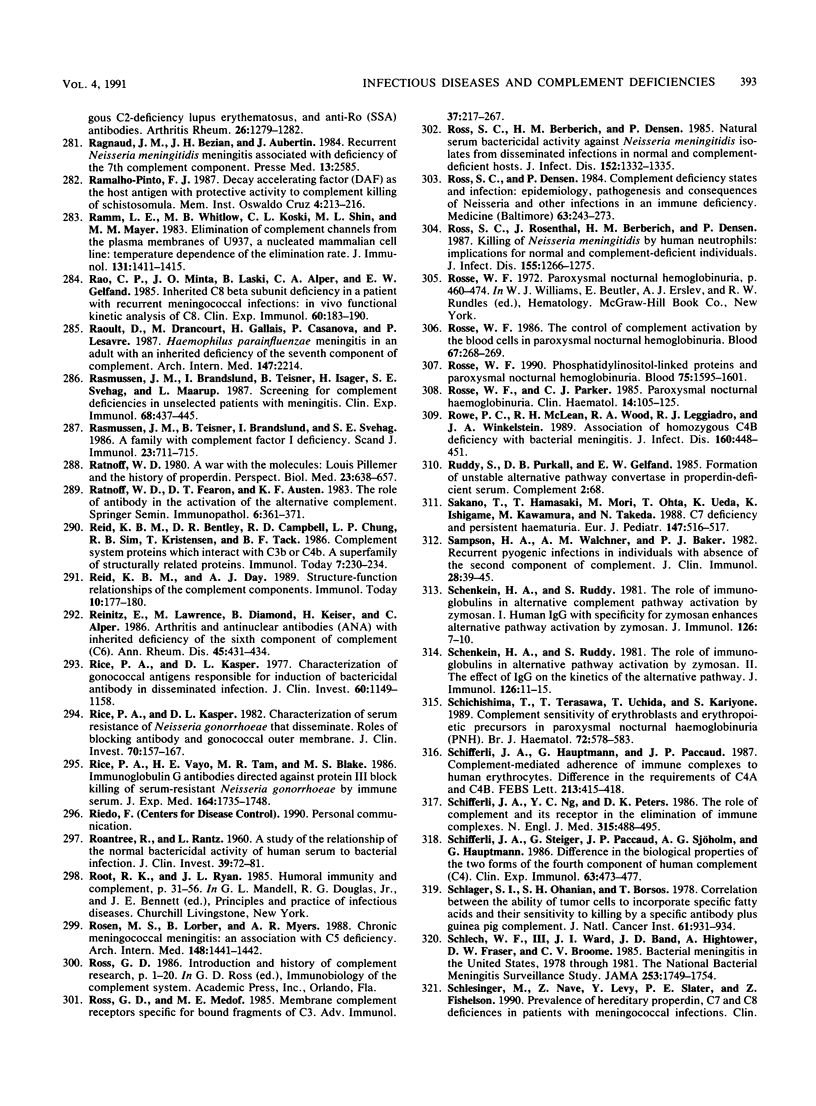
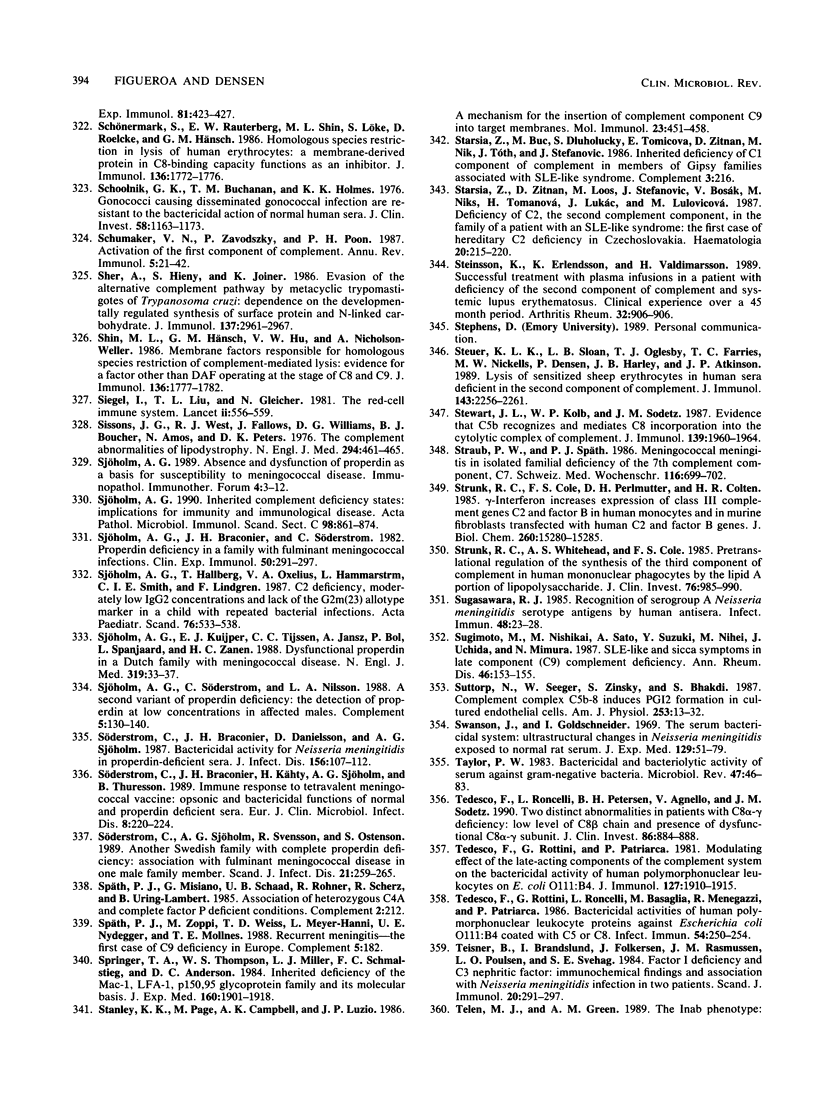
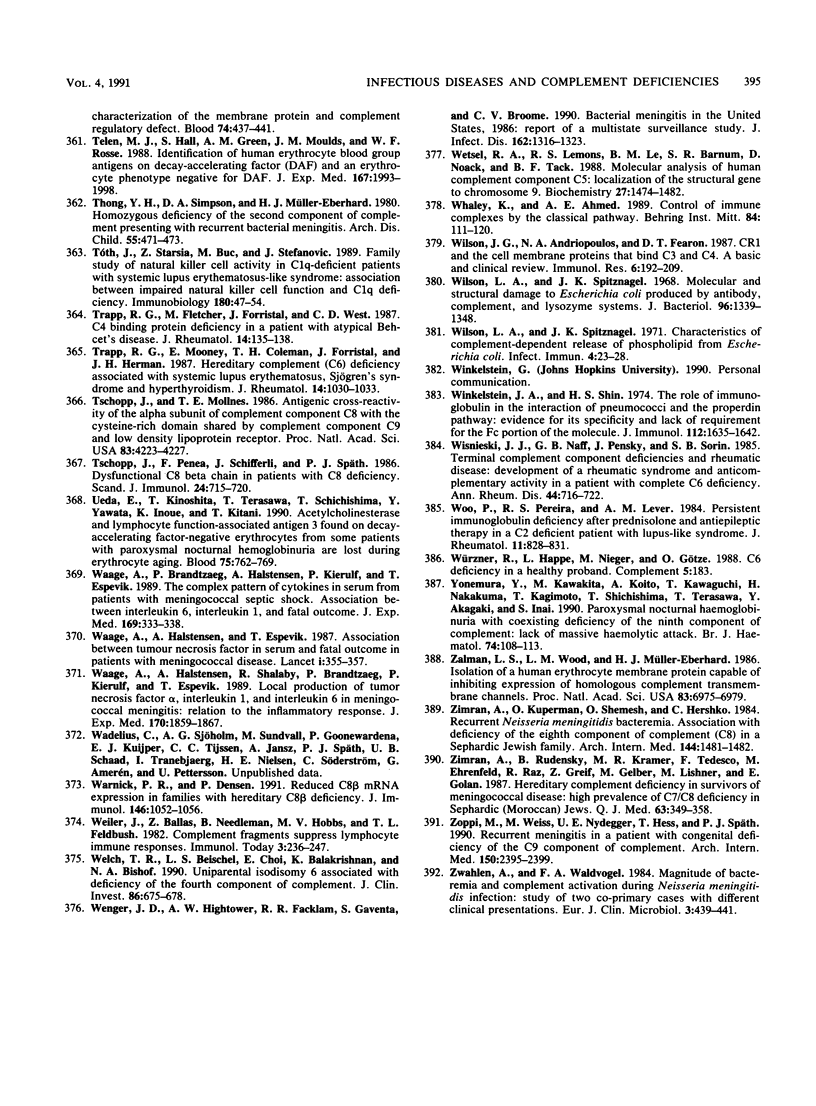
Selected References
These references are in PubMed. This may not be the complete list of references from this article.
- Adams E. M., Hustead S., Rubin P., Wagner R., Gewurz A., Graziano F. M. Absence of the seventh component of complement in a patient with chronic meningococcemia presenting as vasculitis. Ann Intern Med. 1983 Jul;99(1):35–38. doi: 10.7326/0003-4819-99-1-35. [DOI] [PubMed] [Google Scholar]
- Agnello V. Complement deficiency states. Medicine (Baltimore) 1978 Jan;57(1):1–23. doi: 10.1097/00005792-197801000-00001. [DOI] [PubMed] [Google Scholar]
- Alper C. A., Raum D., Awdeh Z. L., Petersen B. H., Taylor P. D., Starzl T. E. Studies of hepatic synthesis in vivo of plasma proteins, including orosomucoid, transferrin, alpha 1-antitrypsin, C8, and factor B. Clin Immunol Immunopathol. 1980 May;16(1):84–89. doi: 10.1016/0090-1229(80)90169-5. [DOI] [PubMed] [Google Scholar]
- Alper C. A., Raum D., Karp S., Awdeh Z. L., Yunis E. J. Serum complement 'supergenes' of the major histocompatibility complex in man (complotypes). Vox Sang. 1983;45(1):62–67. doi: 10.1111/j.1423-0410.1983.tb04124.x. [DOI] [PubMed] [Google Scholar]
- Anderson D. C., Schmalsteig F. C., Finegold M. J., Hughes B. J., Rothlein R., Miller L. J., Kohl S., Tosi M. F., Jacobs R. L., Waldrop T. C. The severe and moderate phenotypes of heritable Mac-1, LFA-1 deficiency: their quantitative definition and relation to leukocyte dysfunction and clinical features. J Infect Dis. 1985 Oct;152(4):668–689. doi: 10.1093/infdis/152.4.668. [DOI] [PubMed] [Google Scholar]
- Aoun L., Cremieux A. C., Casin I., Morel P., Martin P. M. Serum antibody response to the 70,000-molecular-weight neisserial common antigen in humans infected by Neisseria gonorrhoeae. J Clin Microbiol. 1988 Sep;26(9):1898–1900. doi: 10.1128/jcm.26.9.1898-1900.1988. [DOI] [PMC free article] [PubMed] [Google Scholar]
- Arnaout M. A., Dana N., Gupta S. K., Tenen D. G., Fathallah D. M. Point mutations impairing cell surface expression of the common beta subunit (CD18) in a patient with leukocyte adhesion molecule (Leu-CAM) deficiency. J Clin Invest. 1990 Mar;85(3):977–981. doi: 10.1172/JCI114529. [DOI] [PMC free article] [PubMed] [Google Scholar]
- Atkinson J. P. Complement deficiency: predisposing factor to autoimmune syndromes. Clin Exp Rheumatol. 1989 Sep-Oct;7 (Suppl 3):S95–101. [PubMed] [Google Scholar]
- Awdeh Z. L., Raum D. D., Glass D., Agnello V., Schur P. H., Johnston R. B., Jr, Gelfand E. W., Ballow M., Yunis E., Alper C. A. Complement-human histocompatibility antigen haplotypes in C2 deficiency. J Clin Invest. 1981 Feb;67(2):581–583. doi: 10.1172/JCI110070. [DOI] [PMC free article] [PubMed] [Google Scholar]
- Awdeh Z. L., Raum D., Yunis E. J., Alper C. A. Extended HLA/complement allele haplotypes: evidence for T/t-like complex in man. Proc Natl Acad Sci U S A. 1983 Jan;80(1):259–263. doi: 10.1073/pnas.80.1.259. [DOI] [PMC free article] [PubMed] [Google Scholar]
- Barrett D. J., Boyle M. D. Restoration of complement function in vivo by plasma infusion in factor I (C3b inactivator) deficiency. J Pediatr. 1984 Jan;104(1):76–81. doi: 10.1016/s0022-3476(84)80593-4. [DOI] [PubMed] [Google Scholar]
- Baumann H., Richards C., Gauldie J. Interaction among hepatocyte-stimulating factors, interleukin 1, and glucocorticoids for regulation of acute phase plasma proteins in human hepatoma (HepG2) cells. J Immunol. 1987 Dec 15;139(12):4122–4128. [PubMed] [Google Scholar]
- Beatty D. W., Ryder C. R., Heese H. D. Complement abnormalities during an epidemic of group B meningococcal infection in children. Clin Exp Immunol. 1986 Jun;64(3):465–470. [PMC free article] [PubMed] [Google Scholar]
- Belt K. T., Carroll M. C., Porter R. R. The structural basis of the multiple forms of human complement component C4. Cell. 1984 Apr;36(4):907–914. doi: 10.1016/0092-8674(84)90040-0. [DOI] [PubMed] [Google Scholar]
- Bennett R. E., Clough J. D., Calabrese L. H. Fulminating vasculitis in a homozygous C2-deficient patient. Cleve Clin Q. 1985 Summer;52(2):213–215. doi: 10.3949/ccjm.52.2.213. [DOI] [PubMed] [Google Scholar]
- Betz M., Hänsch G. M. Release of arachidonic acid: a new function of the late complement components. Immunobiology. 1984 May;166(4-5):473–483. doi: 10.1016/S0171-2985(84)80024-8. [DOI] [PubMed] [Google Scholar]
- Bhakdi S., Maillet F., Muhly M., Kazatchkine M. D. The cytolytic C5b-9 complement complex: feedback inhibition of complement activation. Proc Natl Acad Sci U S A. 1988 Mar;85(6):1912–1916. doi: 10.1073/pnas.85.6.1912. [DOI] [PMC free article] [PubMed] [Google Scholar]
- Bishof N. A., Welch T. R., Beischel L. S. C4B deficiency: a risk factor for bacteremia with encapsulated organisms. J Infect Dis. 1990 Jul;162(1):248–250. doi: 10.1093/infdis/162.1.248. [DOI] [PubMed] [Google Scholar]
- Black J. R., Black W. J., Cannon J. G. Neisserial antigen H.8 is immunogenic in patients with disseminated gonococcal and meningococcal infections. J Infect Dis. 1985 Apr;151(4):650–657. doi: 10.1093/infdis/151.4.650. [DOI] [PubMed] [Google Scholar]
- Boelaert J., Joos R., Criel A., Van Landuyt H. W., Daha M. R. C5 deficiency in a white family. Arch Intern Med. 1985 Jul;145(7):1333–1333. [PubMed] [Google Scholar]
- Borzy M. S., Houghton D. Mixed-pattern immune deposit glomerulonephritis in a child with inherited deficiency of the third component of complement. Am J Kidney Dis. 1985 Jan;5(1):54–59. doi: 10.1016/s0272-6386(85)80137-2. [DOI] [PubMed] [Google Scholar]
- Borzy M. S., Wolff L., Gewurz A., Buist N. R., Lovrien E. Recurrent sepsis with deficiencies of C2 and galactokinase. Am J Dis Child. 1984 Feb;138(2):186–191. doi: 10.1001/archpedi.1984.02140400068017. [DOI] [PubMed] [Google Scholar]
- Botto M., Fong K. Y., So A. K., Rudge A., Walport M. J. Molecular basis of hereditary C3 deficiency. J Clin Invest. 1990 Oct;86(4):1158–1163. doi: 10.1172/JCI114821. [DOI] [PMC free article] [PubMed] [Google Scholar]
- Braathen L. R., Bratlie A., Teisberg P. HLA genotypes in a family with a case of homozygous C2 deficiency and discoid lupus erythematosus. Acta Derm Venereol. 1986;66(5):419–422. [PubMed] [Google Scholar]
- Braconier J. H., Sjöholm A. G., Söderström C. Fulminant meningococcal infections in a family with inherited deficiency of properdin. Scand J Infect Dis. 1983;15(4):339–345. doi: 10.3109/inf.1983.15.issue-4.04. [DOI] [PubMed] [Google Scholar]
- Brandslund I., Teisner B., Strate M., Grunnet N., Svehag S. E., Isager H., Wang P. The normal occurrence of two molecular forms of the eight complement component (C8) and their concentrations in a family with C8 deficiency. Eur J Clin Invest. 1983 Apr;13(2):179–182. doi: 10.1111/j.1365-2362.1983.tb00084.x. [DOI] [PubMed] [Google Scholar]
- Brandtzaeg P., Joø G. B., Brusletto B., Kierulf P. Plasminogen activator inhibitor 1 and 2, alpha-2-antiplasmin, plasminogen, and endotoxin levels in systemic meningococcal disease. Thromb Res. 1990 Jan 15;57(2):271–278. doi: 10.1016/0049-3848(90)90326-8. [DOI] [PubMed] [Google Scholar]
- Brandtzaeg P., Kierulf P., Gaustad P., Skulberg A., Bruun J. N., Halvorsen S., Sørensen E. Plasma endotoxin as a predictor of multiple organ failure and death in systemic meningococcal disease. J Infect Dis. 1989 Feb;159(2):195–204. doi: 10.1093/infdis/159.2.195. [DOI] [PubMed] [Google Scholar]
- Brandtzaeg P., Mollnes T. E., Kierulf P. Complement activation and endotoxin levels in systemic meningococcal disease. J Infect Dis. 1989 Jul;160(1):58–65. doi: 10.1093/infdis/160.1.58. [DOI] [PubMed] [Google Scholar]
- Brandtzaeg P., Sandset P. M., Joø G. B., Ovstebø R., Abildgaard U., Kierulf P. The quantitative association of plasma endotoxin, antithrombin, protein C, extrinsic pathway inhibitor and fibrinopeptide A in systemic meningococcal disease. Thromb Res. 1989 Aug 15;55(4):459–470. doi: 10.1016/0049-3848(89)90054-6. [DOI] [PubMed] [Google Scholar]
- Brown E. J. Interaction of gram-positive microorganisms with complement. Curr Top Microbiol Immunol. 1985;121:159–187. doi: 10.1007/978-3-642-45604-6_8. [DOI] [PubMed] [Google Scholar]
- Brown E. J., Joiner K. A., Cole R. M., Berger M. Localization of complement component 3 on Streptococcus pneumoniae: anti-capsular antibody causes complement deposition on the pneumococcal capsule. Infect Immun. 1983 Jan;39(1):403–409. doi: 10.1128/iai.39.1.403-409.1983. [DOI] [PMC free article] [PubMed] [Google Scholar]
- Brown E. J., Joiner K. A., Frank M. M. The role of complement in host resistance to bacteria. Springer Semin Immunopathol. 1983;6(4):349–360. doi: 10.1007/BF02116279. [DOI] [PubMed] [Google Scholar]
- Burdash N. M., Blackburn B. B., Farrar W. E., Jr Meningococcal meningitis and complement (C6) deficiency. J S C Med Assoc. 1983 Aug;79(8):440–441. [PubMed] [Google Scholar]
- Böttger E. C., Hoffmann T., Hadding U., Bitter-Suermann D. Guinea pigs with inherited deficiencies of complement components C2 or C4 have characteristics of immune complex disease. J Clin Invest. 1986 Sep;78(3):689–695. doi: 10.1172/JCI112628. [DOI] [PMC free article] [PubMed] [Google Scholar]
- Callen J. P., Hodge S. J., Kulick K. B., Stelzer G., Buchino J. J. Subacute cutaneous lupus erythematosus in multiple members of a family with C2 deficiency. Arch Dermatol. 1987 Jan;123(1):66–70. [PubMed] [Google Scholar]
- Campbell A. K., Luzio J. P. Intracellular free calcium as a pathogen in cell damage initiated by the immune system. Experientia. 1981 Oct 15;37(10):1110–1112. doi: 10.1007/BF02085041. [DOI] [PubMed] [Google Scholar]
- Campbell R. D., Law S. K., Reid K. B., Sim R. B. Structure, organization, and regulation of the complement genes. Annu Rev Immunol. 1988;6:161–195. doi: 10.1146/annurev.iy.06.040188.001113. [DOI] [PubMed] [Google Scholar]
- Campbell R. D. The molecular genetics and polymorphism of C2 and factor B. Br Med Bull. 1987 Jan;43(1):37–49. doi: 10.1093/oxfordjournals.bmb.a072175. [DOI] [PubMed] [Google Scholar]
- Capel P. J., Groeneboer O., Grosveld G., Pondman K. W. The binding of activated C3 to polysaccharides and immunoglobulins. J Immunol. 1978 Dec;121(6):2566–2572. [PubMed] [Google Scholar]
- Carney D. F., Koski C. L., Shin M. L. Elimination of terminal complement intermediates from the plasma membrane of nucleated cells: the rate of disappearance differs for cells carrying C5b-7 or C5b-8 or a mixture of C5b-8 with a limited number of C5b-9. J Immunol. 1985 Mar;134(3):1804–1809. [PubMed] [Google Scholar]
- Carroll M. C., Fathallah D. M., Bergamaschini L., Alicot E. M., Isenman D. E. Substitution of a single amino acid (aspartic acid for histidine) converts the functional activity of human complement C4B to C4A. Proc Natl Acad Sci U S A. 1990 Sep;87(17):6868–6872. doi: 10.1073/pnas.87.17.6868. [DOI] [PMC free article] [PubMed] [Google Scholar]
- Cesbron J. Y., Maillet F., Valance J., Langlet N., Kazatchkine M. Déficit homozygote en C5 révélé par une méningite purulente à Neisseria meningitidis. Presse Med. 1985 Dec 21;14(45):2287–2289. [PubMed] [Google Scholar]
- Chakravarti D. N., Chakravarti B., Parra C. A., Muller-Eberhard H. J. Structural homology of complement protein C6 with other channel-forming proteins of complement. Proc Natl Acad Sci U S A. 1989 Apr;86(8):2799–2803. doi: 10.1073/pnas.86.8.2799. [DOI] [PMC free article] [PubMed] [Google Scholar]
- Chapel H. M., Peto T. E., Luzzi G. A., Thompson R. A., Fielder A. H., Batchelor J. R. Combined familial C7 and C4B deficiency in an adult with meningococcal disease. Clin Exp Immunol. 1987 Jan;67(1):55–58. [PMC free article] [PubMed] [Google Scholar]
- Cole F. S., Auerbach H. S., Goldberger G., Colten H. R. Tissue-specific pretranslational regulation of complement production in human mononuclear phagocytes. J Immunol. 1985 Apr;134(4):2610–2616. [PubMed] [Google Scholar]
- Cole F. S., Whitehead A. S., Auerbach H. S., Lint T., Zeitz H. J., Kilbridge P., Colten H. R. The molecular basis for genetic deficiency of the second component of human complement. N Engl J Med. 1985 Jul 4;313(1):11–16. doi: 10.1056/NEJM198507043130103. [DOI] [PubMed] [Google Scholar]
- Cooke R. P., Zafar M., Haeney M. R. Recurrent meningococcal meningitis associated with deficiencies of C8 and anti-meningococcal antibody. J Clin Lab Immunol. 1987 May;23(1):53–56. [PubMed] [Google Scholar]
- Cooper J. F., Gregory D. W. Recurrent meningitis in a black man. South Med J. 1989 Feb;82(2):235–237. doi: 10.1097/00007611-198902000-00019. [DOI] [PubMed] [Google Scholar]
- Cooper N. R., Moore M. D., Nemerow G. R. Immunobiology of CR2, the B lymphocyte receptor for Epstein-Barr virus and the C3d complement fragment. Annu Rev Immunol. 1988;6:85–113. doi: 10.1146/annurev.iy.06.040188.000505. [DOI] [PubMed] [Google Scholar]
- Cooper N. R. The classical complement pathway: activation and regulation of the first complement component. Adv Immunol. 1985;37:151–216. doi: 10.1016/s0065-2776(08)60340-5. [DOI] [PubMed] [Google Scholar]
- Cornacoff J. B., Hebert L. A., Smead W. L., VanAman M. E., Birmingham D. J., Waxman F. J. Primate erythrocyte-immune complex-clearing mechanism. J Clin Invest. 1983 Feb;71(2):236–247. doi: 10.1172/JCI110764. [DOI] [PMC free article] [PubMed] [Google Scholar]
- Coto E., Martínez-Naves E., Domínguez O., López-Larrea C. DNA polymorphism of the human complement component C7 gene in familial deficiencies. Hum Genet. 1990 Jul;85(2):251–252. doi: 10.1007/BF00193207. [DOI] [PubMed] [Google Scholar]
- Del Rio C., Stephens D. S., Knapp J. S., Rice R. J., Schalla W. O. Comparison of isolates of Neisseria gonorrhoeae causing meningitis and report of gonococcal meningitis in a patient with C8 deficiency. J Clin Microbiol. 1989 May;27(5):1045–1049. doi: 10.1128/jcm.27.5.1045-1049.1989. [DOI] [PMC free article] [PubMed] [Google Scholar]
- Densen P., Brown E. J., O'Neill G. J., Tedesco F., Clark R. A., Frank M. M., Webb D., Myers J. Inherited deficiency of C8 in a patient with recurrent meningococcal infections: further evidence for a dysfunctional C8 molecule and nonlinkage to the HLA system. J Clin Immunol. 1983 Jan;3(1):90–99. doi: 10.1007/BF00919144. [DOI] [PubMed] [Google Scholar]
- Densen P., Gulati S., Rice P. A. Specificity of antibodies against Neisseria gonorrhoeae that stimulate neutrophil chemotaxis. Role of antibodies directed against lipooligosaccharides. J Clin Invest. 1987 Jul;80(1):78–87. doi: 10.1172/JCI113067. [DOI] [PMC free article] [PubMed] [Google Scholar]
- Densen P. Interaction of complement with Neisseria meningitidis and Neisseria gonorrhoeae. Clin Microbiol Rev. 1989 Apr;2 (Suppl):S11–S17. doi: 10.1128/cmr.2.suppl.s11. [DOI] [PMC free article] [PubMed] [Google Scholar]
- Densen P., Weiler J. M., Griffiss J. M., Hoffmann L. G. Familial properdin deficiency and fatal meningococcemia. Correction of the bactericidal defect by vaccination. N Engl J Med. 1987 Apr 9;316(15):922–926. doi: 10.1056/NEJM198704093161506. [DOI] [PubMed] [Google Scholar]
- DiScipio R. G., Hugli T. E. The molecular architecture of human complement component C6. J Biol Chem. 1989 Sep 25;264(27):16197–16206. [PubMed] [Google Scholar]
- Dodds A. W., Law S. K., Porter R. R. The origin of the very variable haemolytic activities of the common human complement component C4 allotypes including C4-A6. EMBO J. 1985 Sep;4(9):2239–2244. doi: 10.1002/j.1460-2075.1985.tb03920.x. [DOI] [PMC free article] [PubMed] [Google Scholar]
- Eby W. M., Irby W. R., Irby J. H., Ruddy S. Recurrent meningitis with familial C8 deficiency: case report. Va Med. 1987 Feb;114(2):91–94. [PubMed] [Google Scholar]
- Edwards J. E., Jr, Gaither T. A., O'Shea J. J., Rotrosen D., Lawley T. J., Wright S. A., Frank M. M., Green I. Expression of specific binding sites on Candida with functional and antigenic characteristics of human complement receptors. J Immunol. 1986 Dec 1;137(11):3577–3583. [PubMed] [Google Scholar]
- Edwards M. S., Kasper D. L., Jennings H. J., Baker C. J., Nicholson-Weller A. Capsular sialic acid prevents activation of the alternative complement pathway by type III, group B streptococci. J Immunol. 1982 Mar;128(3):1278–1283. [PubMed] [Google Scholar]
- Ehrenfeld M., Urowitz M. B., Platts M. E. Selective C4 deficiency, systemic lupus erythematosus, and Whipple's disease. Ann Rheum Dis. 1984 Feb;43(1):91–94. doi: 10.1136/ard.43.1.91. [DOI] [PMC free article] [PubMed] [Google Scholar]
- Eichenfield L. F., Johnston R. B., Jr Secondary disorders of the complement system. Am J Dis Child. 1989 May;143(5):595–602. doi: 10.1001/archpedi.1989.02150170097032. [DOI] [PubMed] [Google Scholar]
- Ellison R. T., 3rd, Curd J. G., Kohler P. F., Reller L. B., Judson F. N. Underlying complement deficiency in patients with disseminated gonococcal infection. Sex Transm Dis. 1987 Oct-Dec;14(4):201–204. doi: 10.1097/00007435-198710000-00004. [DOI] [PubMed] [Google Scholar]
- Ellison R. T., 3rd, Horsburgh C. R., Jr, Curd J. Complement levels in patients with hepatic dysfunction. Dig Dis Sci. 1990 Feb;35(2):231–235. doi: 10.1007/BF01536768. [DOI] [PubMed] [Google Scholar]
- Ellison R. T., 3rd, Kohler P. F., Curd J. G., Judson F. N., Reller L. B. Prevalence of congenital or acquired complement deficiency in patients with sporadic meningocococcal disease. N Engl J Med. 1983 Apr 21;308(16):913–916. doi: 10.1056/NEJM198304213081601. [DOI] [PubMed] [Google Scholar]
- Ellison R. T., 3rd, Mason S. R., Kohler P. F., Curd J. G., Reller L. B. Meningococcemia and acquired complement deficiency. Association in patients with hepatic failure. Arch Intern Med. 1986 Aug;146(8):1539–1540. [PubMed] [Google Scholar]
- Eng R. H. Bactericidal screening test for late complement component deficiencies or defects. J Clin Microbiol. 1980 Jun;11(6):631–634. doi: 10.1128/jcm.11.6.631-634.1980. [DOI] [PMC free article] [PubMed] [Google Scholar]
- Engebretsen L. F., Kierulf P., Brandtzaeg P. Extreme plasminogen activator inhibitor and endotoxin values in patients with meningococcal disease. Thromb Res. 1986 Jun 1;42(5):713–716. doi: 10.1016/0049-3848(86)90351-8. [DOI] [PubMed] [Google Scholar]
- Estabrook M. M., Mandrell R. E., Apicella M. A., Griffiss J. M. Measurement of the human immune response to meningococcal lipooligosaccharide antigens by using serum to inhibit monoclonal antibody binding to purified lipooligosaccharide. Infect Immun. 1990 Jul;58(7):2204–2213. doi: 10.1128/iai.58.7.2204-2213.1990. [DOI] [PMC free article] [PubMed] [Google Scholar]
- Farhoudi A. H. Méningite pneumococcique répétée accompagnée de déficit en C3. Presse Med. 1988 Apr 16;17(14):696–696. [PubMed] [Google Scholar]
- Fasano M. B., Densen P., McLean R. H., Winkelstein J. A. Prevalence of homozygous C4B deficiency in patients with deficiencies of terminal complement components and meningococcemia. J Infect Dis. 1990 Nov;162(5):1220–1221. doi: 10.1093/infdis/162.5.1220. [DOI] [PubMed] [Google Scholar]
- Fearon D. T., Austen K. F. Activation of the alternative complement pathway due to resistance of zymosan-bound amplification convertase to endogenous regulatory mechanisms. Proc Natl Acad Sci U S A. 1977 Apr;74(4):1683–1687. doi: 10.1073/pnas.74.4.1683. [DOI] [PMC free article] [PubMed] [Google Scholar]
- Fearon D. T., Austen K. F. Activation of the alternative complement pathway with rabbit erythrocytes by circumvention of the regulatory action of endogenous control proteins. J Exp Med. 1977 Jul 1;146(1):22–33. doi: 10.1084/jem.146.1.22. [DOI] [PMC free article] [PubMed] [Google Scholar]
- Fearon D. T., Austen K. F. Current concepts in immunology: the alternative pathway of complement--a system for host resistance to microbial infection. N Engl J Med. 1980 Jul 31;303(5):259–263. doi: 10.1056/NEJM198007313030505. [DOI] [PubMed] [Google Scholar]
- Fearon D. T., Austen K. F. Properdin: binding to C3b and stabilization of the C3b-dependent C3 convertase. J Exp Med. 1975 Oct 1;142(4):856–863. doi: 10.1084/jem.142.4.856. [DOI] [PMC free article] [PubMed] [Google Scholar]
- Fearon D. T., Austen K. F. Properdin: initiation of alternative complement pathway. Proc Natl Acad Sci U S A. 1975 Aug;72(8):3220–3224. doi: 10.1073/pnas.72.8.3220. [DOI] [PMC free article] [PubMed] [Google Scholar]
- Fearon D. T. Continuing medical education. This continuing medical education self-assessment program is sponsored by the American Academy of Allergy and Immunology and supported by a grant-in-aid from Fisons Corporation. J Allergy Clin Immunol. 1983 Jun;71(6):520–532. doi: 10.1016/0091-6749(83)90431-1. [DOI] [PubMed] [Google Scholar]
- Fearon D. T. Regulation by membrane sialic acid of beta1H-dependent decay-dissociation of amplification C3 convertase of the alternative complement pathway. Proc Natl Acad Sci U S A. 1978 Apr;75(4):1971–1975. doi: 10.1073/pnas.75.4.1971. [DOI] [PMC free article] [PubMed] [Google Scholar]
- Fearon D. T., Wong W. W. Complement ligand-receptor interactions that mediate biological responses. Annu Rev Immunol. 1983;1:243–271. doi: 10.1146/annurev.iy.01.040183.001331. [DOI] [PubMed] [Google Scholar]
- Fijen C. A., Kuijper E. J., Hannema A. J., Sjöholm A. G., van Putten J. P. Complement deficiencies in patients over ten years old with meningococcal disease due to uncommon serogroups. Lancet. 1989 Sep 9;2(8663):585–588. doi: 10.1016/s0140-6736(89)90712-5. [DOI] [PubMed] [Google Scholar]
- Fine D. P., Gewurz H., Griffiss M., Lint T. F. Meningococcal meningitis in a women with inherited deficiency of the ninth component of complement. Clin Immunol Immunopathol. 1983 Sep;28(3):413–417. doi: 10.1016/0090-1229(83)90108-3. [DOI] [PubMed] [Google Scholar]
- Friedman H. M., Cohen G. H., Eisenberg R. J., Seidel C. A., Cines D. B. Glycoprotein C of herpes simplex virus 1 acts as a receptor for the C3b complement component on infected cells. Nature. 1984 Jun 14;309(5969):633–635. doi: 10.1038/309633a0. [DOI] [PubMed] [Google Scholar]
- Friedman H. M., Glorioso J. C., Cohen G. H., Hastings J. C., Harris S. L., Eisenberg R. J. Binding of complement component C3b to glycoprotein gC of herpes simplex virus type 1: mapping of gC-binding sites and demonstration of conserved C3b binding in low-passage clinical isolates. J Virol. 1986 Nov;60(2):470–475. doi: 10.1128/jvi.60.2.470-475.1986. [DOI] [PMC free article] [PubMed] [Google Scholar]
- Fries L. F., Gaither T. A., Hammer C. H., Frank M. M. C3b covalently bound to IgG demonstrates a reduced rate of inactivation by factors H and I. J Exp Med. 1984 Dec 1;160(6):1640–1655. doi: 10.1084/jem.160.6.1640. [DOI] [PMC free article] [PubMed] [Google Scholar]
- Garred P., Mollnes T. E., Thorsteinsson L., Erlendsson K., Steinsson K. Increased amounts of C4-containing immune complexes and inefficient activation of C3 and the terminal complement pathway in a patient with homozygous C2 deficiency and systemic lupus erythematosus. Scand J Immunol. 1990 Jan;31(1):59–64. doi: 10.1111/j.1365-3083.1990.tb02743.x. [DOI] [PubMed] [Google Scholar]
- Gelfand E. W., Rao C. P., Minta J. O., Ham T., Purkall D. B., Ruddy S. Inherited deficiency of properdin and C2 in a patient with recurrent bacteremia. Am J Med. 1987 Mar 23;82(3 Spec No):671–675. doi: 10.1016/0002-9343(87)90122-7. [DOI] [PubMed] [Google Scholar]
- Gianella-Borradori A., Borradori L., Schneider P. M., Gautier E., Späth P. J. Combined complete C5 and partial C4 deficiency in humans: clinical consequences and complement-mediated functions in vitro. Clin Immunol Immunopathol. 1990 Apr;55(1):41–55. doi: 10.1016/0090-1229(90)90067-z. [DOI] [PubMed] [Google Scholar]
- Giles C. M., Swanson J. L. Anti-C4 in the serum of a transfused C4-deficient patient with systemic lupus erythematosus. Vox Sang. 1984;46(5):291–299. doi: 10.1111/j.1423-0410.1984.tb00089.x. [DOI] [PubMed] [Google Scholar]
- Gilmore B. J., Retsinas E. M., Lorenz J. S., Hostetter M. K. An iC3b receptor on Candida albicans: structure, function, and correlates for pathogenicity. J Infect Dis. 1988 Jan;157(1):38–46. doi: 10.1093/infdis/157.1.38. [DOI] [PubMed] [Google Scholar]
- Girardin E., Grau G. E., Dayer J. M., Roux-Lombard P., Lambert P. H. Tumor necrosis factor and interleukin-1 in the serum of children with severe infectious purpura. N Engl J Med. 1988 Aug 18;319(7):397–400. doi: 10.1056/NEJM198808183190703. [DOI] [PubMed] [Google Scholar]
- Glass D., Raum D., Gibson D., Stillman J. S., Schur P. H. Inherited deficiency of the second component of complement. Rheumatic disease associations. J Clin Invest. 1976 Oct;58(4):853–861. doi: 10.1172/JCI108538. [DOI] [PMC free article] [PubMed] [Google Scholar]
- Goldschneider I., Gotschlich E. C., Artenstein M. S. Human immunity to the meningococcus. I. The role of humoral antibodies. J Exp Med. 1969 Jun 1;129(6):1307–1326. doi: 10.1084/jem.129.6.1307. [DOI] [PMC free article] [PubMed] [Google Scholar]
- Goldschneider I., Gotschlich E. C., Artenstein M. S. Human immunity to the meningococcus. II. Development of natural immunity. J Exp Med. 1969 Jun 1;129(6):1327–1348. doi: 10.1084/jem.129.6.1327. [DOI] [PMC free article] [PubMed] [Google Scholar]
- Goonewardena P., Sjöholm A. G., Nilsson L. A., Pettersson U. Linkage analysis of the properdin deficiency gene: suggestion of a locus in the proximal part of the short arm of the X chromosome. Genomics. 1988 Feb;2(2):115–118. doi: 10.1016/0888-7543(88)90092-4. [DOI] [PubMed] [Google Scholar]
- Gordon D. L., Hostetter M. K. Complement and host defence against microorganisms. Pathology. 1986 Oct;18(4):365–375. doi: 10.3109/00313028609087551. [DOI] [PubMed] [Google Scholar]
- Goundis D., Holt S. M., Boyd Y., Reid K. B. Localization of the properdin structural locus to Xp11.23-Xp21.1. Genomics. 1989 Jul;5(1):56–60. doi: 10.1016/0888-7543(89)90085-2. [DOI] [PubMed] [Google Scholar]
- Greenwood B. M., Onyewotu I. I., Whittle H. C. Complement and meningococcal infection. Br Med J. 1976 Apr 3;1(6013):797–799. doi: 10.1136/bmj.1.6013.797. [DOI] [PMC free article] [PubMed] [Google Scholar]
- Griffiss J. M. Bactericidal activity of meningococcal antisera. Blocking by IgA of lytic antibody in human convalescent sera. J Immunol. 1975 Jun;114(6):1779–1784. [PubMed] [Google Scholar]
- Griffiss J. M., Bertram M. A. Immunoepidemiology of meningococcal disease in military recruits. II. Blocking of serum bactericidal activity by circulating IgA early in the course of invasive disease. J Infect Dis. 1977 Dec;136(6):733–739. doi: 10.1093/infdis/136.6.733. [DOI] [PubMed] [Google Scholar]
- Griffiss J. M., Brandt B. L., Broud D. D., Goroff D. K., Baker C. J. Immune response of infants and children to disseminated infections with Neisseria meningitidis. J Infect Dis. 1984 Jul;150(1):71–79. doi: 10.1093/infdis/150.1.71. [DOI] [PubMed] [Google Scholar]
- Griffiss J. M. Epidemic meningococcal disease: synthesis of a hypothetical immunoepidemiologic model. Rev Infect Dis. 1982 Jan-Feb;4(1):159–172. doi: 10.1093/clinids/4.1.159. [DOI] [PubMed] [Google Scholar]
- Griffiss J. M., Goroff D. K. IgA blocks IgM and IgG-initiated immune lysis by separate molecular mechanisms. J Immunol. 1983 Jun;130(6):2882–2885. [PubMed] [Google Scholar]
- Grossman N., Leive L. Complement activation via the alternative pathway by purified Salmonella lipopolysaccharide is affected by its structure but not its O-antigen length. J Immunol. 1984 Jan;132(1):376–385. [PubMed] [Google Scholar]
- Grumach A. S., Vilela M. M., Gonzalez C. H., Starobinas N., Pereira A. B., Dias-da-Silva W., Carneiro-Sampaio M. M. Inherited C3 deficiency of the complement system. Braz J Med Biol Res. 1988;21(2):247–257. [PubMed] [Google Scholar]
- HAESSIG A., BOREL J. F., AMMANN P., THOENI M., BUETLER R. ESSENTIELLE HYPOKOMPLEMENTAEMIE. Pathol Microbiol (Basel) 1964;27:542–547. [PubMed] [Google Scholar]
- Haefliger J. A., Tschopp J., Vial N., Jenne D. E. Complete primary structure and functional characterization of the sixth component of the human complement system. Identification of the C5b-binding domain in complement C6. J Biol Chem. 1989 Oct 25;264(30):18041–18051. [PubMed] [Google Scholar]
- Hannema A. J., Kluin-Nelemans J. C., Hack C. E., Eerenberg-Belmer A. J., Mallée C., van Helden H. P. SLE like syndrome and functional deficiency of C1q in members of a large family. Clin Exp Immunol. 1984 Jan;55(1):106–114. [PMC free article] [PubMed] [Google Scholar]
- Harriman G. R., Esser A. F., Podack E. R., Wunderlich A. C., Braude A. I., Lint T. F., Curd J. G. The role of C9 in complement-mediated killing of Neisseria. J Immunol. 1981 Dec;127(6):2386–2390. [PubMed] [Google Scholar]
- Harriman G. R., Podack E. R., Braude A. I., Corbeil L. C., Esser A. F., Curd J. G. Activation of complement by serum-resistant Neisseria gonorrhoeae. Assembly of the membrane attack complex without subsequent cell death. J Exp Med. 1982 Oct 1;156(4):1235–1249. doi: 10.1084/jem.156.4.1235. [DOI] [PMC free article] [PubMed] [Google Scholar]
- Hauptmann G., Goetz J., Uring-Lambert B., Grosshans E. Component deficiencies. 2. The fourth component. Prog Allergy. 1986;39:232–249. [PubMed] [Google Scholar]
- Hetland G., Eskeland T. Formation of the functional alternative pathway of complement by human monocytes in vitro as demonstrated by phagocytosis of agarose beads. Scand J Immunol. 1986 Mar;23(3):301–308. doi: 10.1111/j.1365-3083.1986.tb01971.x. [DOI] [PubMed] [Google Scholar]
- Hibbs M. L., Wardlaw A. J., Stacker S. A., Anderson D. C., Lee A., Roberts T. M., Springer T. A. Transfection of cells from patients with leukocyte adhesion deficiency with an integrin beta subunit (CD18) restores lymphocyte function-associated antigen-1 expression and function. J Clin Invest. 1990 Mar;85(3):674–681. doi: 10.1172/JCI114491. [DOI] [PMC free article] [PubMed] [Google Scholar]
- Hiemstra P. S., Langeler E., Compier B., Keepers Y., Leijh P. C., van den Barselaar M. T., Overbosch D., Daha M. R. Complete and partial deficiencies of complement factor D in a Dutch family. J Clin Invest. 1989 Dec;84(6):1957–1961. doi: 10.1172/JCI114384. [DOI] [PMC free article] [PubMed] [Google Scholar]
- Hoffman T. A., Edwards E. A. Group-specific polysaccharide antigen and humoral antibody response in disease due to Neisseria meningitidis. J Infect Dis. 1972 Dec;126(6):636–644. doi: 10.1093/infdis/126.6.636. [DOI] [PubMed] [Google Scholar]
- Holguin M. H., Fredrick L. R., Bernshaw N. J., Wilcox L. A., Parker C. J. Isolation and characterization of a membrane protein from normal human erythrocytes that inhibits reactive lysis of the erythrocytes of paroxysmal nocturnal hemoglobinuria. J Clin Invest. 1989 Jul;84(1):7–17. doi: 10.1172/JCI114172. [DOI] [PMC free article] [PubMed] [Google Scholar]
- Holguin M. H., Wilcox L. A., Bernshaw N. J., Rosse W. F., Parker C. J. Erythrocyte membrane inhibitor of reactive lysis: effects of phosphatidylinositol-specific phospholipase C on the isolated and cell-associated protein. Blood. 1990 Jan 1;75(1):284–289. [PubMed] [Google Scholar]
- Holguin M. H., Wilcox L. A., Bernshaw N. J., Rosse W. F., Parker C. J. Relationship between the membrane inhibitor of reactive lysis and the erythrocyte phenotypes of paroxysmal nocturnal hemoglobinuria. J Clin Invest. 1989 Nov;84(5):1387–1394. doi: 10.1172/JCI114311. [DOI] [PMC free article] [PubMed] [Google Scholar]
- Holme E. R., Veitch J., Johnston A., Hauptmann G., Uring-Lambert B., Seywright M., Docherty V., Morley W. N., Whaley K. Familial properdin deficiency associated with chronic discoid lupus erythematosus. Clin Exp Immunol. 1989 Apr;76(1):76–81. [PMC free article] [PubMed] [Google Scholar]
- Howard P. F., Hochberg M. C., Bias W. B., Arnett F. C., Jr, McLean R. H. Relationship between C4 null genes, HLA-D region antigens, and genetic susceptibility to systemic lupus erythematosus in Caucasian and black Americans. Am J Med. 1986 Aug;81(2):187–193. doi: 10.1016/0002-9343(86)90250-0. [DOI] [PubMed] [Google Scholar]
- Hummell D. S., Mocca L. F., Frasch C. E., Winkelstein J. A., Jean-Baptiste H. J., Atilio Canas J., Leggiadro R. J. Meningitis caused by a nonencapsulated strain of Neisseria meningitidis in twin infants with a C6 deficiency. J Infect Dis. 1987 Apr;155(4):815–818. doi: 10.1093/infdis/155.4.815. [DOI] [PubMed] [Google Scholar]
- Hyatt A. C., Altenburger K. M., Johnston R. B., Jr, Winkelstein J. A. Increased susceptibility to severe pyogenic infections in patients with an inherited deficiency of the second component of complement. J Pediatr. 1981 Mar;98(3):417–419. doi: 10.1016/s0022-3476(81)80708-1. [DOI] [PubMed] [Google Scholar]
- Hynes R. O. Integrins: a family of cell surface receptors. Cell. 1987 Feb 27;48(4):549–554. doi: 10.1016/0092-8674(87)90233-9. [DOI] [PubMed] [Google Scholar]
- Hänsch G. M., Hammer C. H., Vanguri P., Shin M. L. Homologous species restriction in lysis of erythrocytes by terminal complement proteins. Proc Natl Acad Sci U S A. 1981 Aug;78(8):5118–5121. doi: 10.1073/pnas.78.8.5118. [DOI] [PMC free article] [PubMed] [Google Scholar]
- Hänsch G. M., Schönermark S., Roelcke D. Paroxysmal nocturnal hemoglobinuria type III. Lack of an erythrocyte membrane protein restricting the lysis by C5b-9. J Clin Invest. 1987 Jul;80(1):7–12. doi: 10.1172/JCI113065. [DOI] [PMC free article] [PubMed] [Google Scholar]
- Hänsch G. M., Seitz M., Martinotti G., Betz M., Rauterberg E. W., Gemsa D. Macrophages release arachidonic acid, prostaglandin E2, and thromboxane in response to late complement components. J Immunol. 1984 Oct;133(4):2145–2150. [PubMed] [Google Scholar]
- Imagawa D. K., Osifchin N. E., Paznekas W. A., Shin M. L., Mayer M. M. Consequences of cell membrane attack by complement: release of arachidonate and formation of inflammatory derivatives. Proc Natl Acad Sci U S A. 1983 Nov;80(21):6647–6651. doi: 10.1073/pnas.80.21.6647. [DOI] [PMC free article] [PubMed] [Google Scholar]
- Ipp M. M., Minta J. O., Gelfand E. W. Disorders of the complement system in lipodystrophy. Clin Immunol Immunopathol. 1977 Mar;7(2):281–287. doi: 10.1016/0090-1229(77)90055-1. [DOI] [PubMed] [Google Scholar]
- Irestedt M., Månsson T., Svensson A. Vasculitis simulating eczematous dermatitis due to C2 deficiency. Acta Derm Venereol. 1987;67(3):265–267. [PubMed] [Google Scholar]
- Irestedt M., Svensson A., Månsson T. Subtotal C4 deficiency and SLE-like disease. Acta Derm Venereol. 1986;66(1):67–70. [PubMed] [Google Scholar]
- Isenman D. E., Young J. R. The molecular basis for the difference in immune hemolysis activity of the Chido and Rodgers isotypes of human complement component C4. J Immunol. 1984 Jun;132(6):3019–3027. [PubMed] [Google Scholar]
- Jamieson D. M., Stafford C. T., Maloney M. J., Lutcher C. L. Desensitization to factor VIII in a patient with classic hemophilia and C2 deficiency. Ann Allergy. 1987 Mar;58(3):215–220. [PubMed] [Google Scholar]
- Jarvis G. A., Vedros N. A. Sialic acid of group B Neisseria meningitidis regulates alternative complement pathway activation. Infect Immun. 1987 Jan;55(1):174–180. doi: 10.1128/iai.55.1.174-180.1987. [DOI] [PMC free article] [PubMed] [Google Scholar]
- Jiménez de Diego L., Fernández Ballesteros A., Varela Donoso A., Martínez Cocera C., Cabezas-Cerrato J. Déficit de C7 asociado a meningitis purulenta de repetición. Med Clin (Barc) 1983 Sep 24;81(8):347–349. [PubMed] [Google Scholar]
- Joiner K. A., Fries L. F., Schmetz M. A., Frank M. M. IgG bearing covalently bound C3b has enhanced bactericidal activity for Escherichia coli 0111. J Exp Med. 1985 Sep 1;162(3):877–889. doi: 10.1084/jem.162.3.877. [DOI] [PMC free article] [PubMed] [Google Scholar]
- Joiner K. A., Grossman N., Schmetz M., Leive L. C3 binds preferentially to long-chain lipopolysaccharide during alternative pathway activation by Salmonella montevideo. J Immunol. 1986 Jan;136(2):710–715. [PubMed] [Google Scholar]
- Joiner K. A., Scales R., Warren K. A., Frank M. M., Rice P. A. Mechanism of action of blocking immunoglobulin G for Neisseria gonorrhoeae. J Clin Invest. 1985 Nov;76(5):1765–1772. doi: 10.1172/JCI112167. [DOI] [PMC free article] [PubMed] [Google Scholar]
- Joiner K. A., Warren K. A., Brown E. J., Swanson J., Frank M. M. Studies on the mechanism of bacterial resistance to complement-mediated killing. IV. C5b-9 forms high molecular weight complexes with bacterial outer membrane constituents on serum-resistant but not on serum-sensitive Neisseria gonorrhoeae. J Immunol. 1983 Sep;131(3):1443–1451. [PubMed] [Google Scholar]
- Joiner K. A., daSilva W. D., Rimoldi M. T., Hammer C. H., Sher A., Kipnis T. L. Biochemical characterization of a factor produced by trypomastigotes of Trypanosoma cruzi that accelerates the decay of complement C3 convertases. J Biol Chem. 1988 Aug 15;263(23):11327–11335. [PubMed] [Google Scholar]
- Joiner K., Hieny S., Kirchhoff L. V., Sher A. gp72, the 72 kilodalton glycoprotein, is the membrane acceptor site for C3 on Trypanosoma cruzi epimastigotes. J Exp Med. 1985 May 1;161(5):1196–1212. doi: 10.1084/jem.161.5.1196. [DOI] [PMC free article] [PubMed] [Google Scholar]
- Joiner K., Sher A., Gaither T., Hammer C. Evasion of alternative complement pathway by Trypanosoma cruzi results from inefficient binding of factor B. Proc Natl Acad Sci U S A. 1986 Sep;83(17):6593–6597. doi: 10.1073/pnas.83.17.6593. [DOI] [PMC free article] [PubMed] [Google Scholar]
- Jones E., Jones J. V., Woodbury J. F., Carr R. I., Skanes V. Scleroderma and hemolytic anemia in a patient with deficiency of IgA and C4: a hitherto undescribed association. J Rheumatol. 1987 Jun;14(3):609–612. [PubMed] [Google Scholar]
- Kajita T., Hugli T. E. C5a-induced neutrophilia. A primary humoral mechanism for recruitment of neutrophils. Am J Pathol. 1990 Aug;137(2):467–477. [PMC free article] [PubMed] [Google Scholar]
- Kaufman K. M., Snider J. V., Spurr N. K., Schwartz C. E., Sodetz J. M. Chromosomal assignment of genes encoding the alpha, beta, and gamma subunits of human complement protein C8: identification of a close physical linkage between the alpha and the beta loci. Genomics. 1989 Oct;5(3):475–480. doi: 10.1016/0888-7543(89)90012-8. [DOI] [PubMed] [Google Scholar]
- Kawai T., Katoh K., Narita M., Tani K., Okubo T. Deficiency of the 9th component of complement (C9) in a patient with systemic lupus erythematosus. J Rheumatol. 1989 Apr;16(4):542–543. [PubMed] [Google Scholar]
- Kazatchkine M. D., Fearon D. T., Austen K. F. Human alternative complement pathway: membrane-associated sialic acid regulates the competition between B and beta1 H for cell-bound C3b. J Immunol. 1979 Jan;122(1):75–81. [PubMed] [Google Scholar]
- Kemp A. S., Vernon J., Muller-Eberhard H. J., Bau D. C. Complement C8 deficiency with recurrent meningococcemia: examination of meningococcal opsonization. Aust Paediatr J. 1985 Aug;21(3):169–171. doi: 10.1111/j.1440-1754.1985.tb02126.x. [DOI] [PubMed] [Google Scholar]
- Kemp M. E., Atkinson J. P., Skanes V. M., Levine R. P., Chaplin D. D. Deletion of C4A genes in patients with systemic lupus erythematosus. Arthritis Rheum. 1987 Sep;30(9):1015–1022. doi: 10.1002/art.1780300908. [DOI] [PubMed] [Google Scholar]
- Kew R. R., Webster R. O. Gc-globulin (vitamin D-binding protein) enhances the neutrophil chemotactic activity of C5a and C5a des Arg. J Clin Invest. 1988 Jul;82(1):364–369. doi: 10.1172/JCI113596. [DOI] [PMC free article] [PubMed] [Google Scholar]
- Kim J. J., Mandrell R. E., Griffiss J. M. Neisseria lactamica and Neisseria meningitidis share lipooligosaccharide epitopes but lack common capsular and class 1, 2, and 3 protein epitopes. Infect Immun. 1989 Feb;57(2):602–608. doi: 10.1128/iai.57.2.602-608.1989. [DOI] [PMC free article] [PubMed] [Google Scholar]
- Kishimoto T. K., Hollander N., Roberts T. M., Anderson D. C., Springer T. A. Heterogeneous mutations in the beta subunit common to the LFA-1, Mac-1, and p150,95 glycoproteins cause leukocyte adhesion deficiency. Cell. 1987 Jul 17;50(2):193–202. doi: 10.1016/0092-8674(87)90215-7. [DOI] [PubMed] [Google Scholar]
- Kishimoto T. K., O'Conner K., Springer T. A. Leukocyte adhesion deficiency. Aberrant splicing of a conserved integrin sequence causes a moderate deficiency phenotype. J Biol Chem. 1989 Feb 25;264(6):3588–3595. [PubMed] [Google Scholar]
- Klein G., Tappeiner G., Hintner H., Scholz S., Wolff K. Systemischer Lupus erythematodes bei hereditärer Defizienz der vierten Komplementkomponente. Hautarzt. 1984 Jan;35(1):27–32. [PubMed] [Google Scholar]
- Kluin-Nelemans H. C., van Velzen-Blad H., van Helden H. P., Daha M. R. Functional deficiency of complement factor D in a monozygous twin. Clin Exp Immunol. 1984 Dec;58(3):724–730. [PMC free article] [PubMed] [Google Scholar]
- Knutzen Steuer K. L., Sloan L. B., Oglesby T. J., Farries T. C., Nickells M. W., Densen P., Harley J. B., Atkinson J. P. Lysis of sensitized sheep erythrocytes in human sera deficient in the second component of complement. J Immunol. 1989 Oct 1;143(7):2256–2261. [PubMed] [Google Scholar]
- Kristensen T., D'Eustachio P., Ogata R. T., Chung L. P., Reid K. B., Tack B. F. The superfamily of C3b/C4b-binding proteins. Fed Proc. 1987 May 15;46(7):2463–2469. [PubMed] [Google Scholar]
- Kusaba T., Kisu T., Inaba S., Sakai K., Okochi K., Yanase T. A pedigree of deficiency of the ninth component of complement (C9). Jinrui Idengaku Zasshi. 1983 Dec;28(4):239–248. doi: 10.1007/BF01876786. [DOI] [PubMed] [Google Scholar]
- Käyhty H., Jousimies-Somer H., Peltola H., Mäketä P. H. Antibody response to capsular polysaccharides of groups A and C neisseria meningitidis and Haemophilus influenzae type b during bacteremic disease. J Infect Dis. 1981 Jan;143(1):32–41. doi: 10.1093/infdis/143.1.32. [DOI] [PubMed] [Google Scholar]
- Lachmann P. J. Genetic deficiencies of the complement system. Boll Ist Sieroter Milan. 1974;53(1):suppl–suppl:207. [PubMed] [Google Scholar]
- Lachmann P. J., Hughes-Jones N. C. Initiation of complement activation. Springer Semin Immunopathol. 1984;7(2-3):143–162. doi: 10.1007/BF01893018. [DOI] [PubMed] [Google Scholar]
- Laham M. N., Caldwell J. R., Panush R. S. Modulation of lymphocyte proliferative responses to mitogens and antigens by complement components C1, C4 and C2. J Clin Lab Immunol. 1982 Oct;9(1):39–47. [PubMed] [Google Scholar]
- Law S. K., Dodds A. W., Porter R. R. A comparison of the properties of two classes, C4A and C4B, of the human complement component C4. EMBO J. 1984 Aug;3(8):1819–1823. doi: 10.1002/j.1460-2075.1984.tb02052.x. [DOI] [PMC free article] [PubMed] [Google Scholar]
- Leggiadro R. J., Warren A. B., Swift A. J., Winkelstein J. A. Meningococcemia in genetically determined deficiency of the second component of complement. J Infect Dis. 1983 Nov;148(5):941–941. doi: 10.1093/infdis/148.5.941. [DOI] [PubMed] [Google Scholar]
- Leggiadro R. J., Winkelstein J. A. Prevalence of complement deficiencies in children with systemic meningococcal infections. Pediatr Infect Dis J. 1987 Jan;6(1):75–76. doi: 10.1097/00006454-198701000-00023. [DOI] [PubMed] [Google Scholar]
- Lepow I. H. Presidential address to American Association of Immunologists in Anaheim, California, April 16, 1980. Louis Pillemer, Properdin, and scientific controversy. J Immunol. 1980 Aug;125(2):471–475. [PubMed] [Google Scholar]
- Levy M., Halbwachs-Mecarelli L., Gubler M. C., Kohout G., Bensenouci A., Niaudet P., Hauptmann G., Lesavre P. H deficiency in two brothers with atypical dense intramembranous deposit disease. Kidney Int. 1986 Dec;30(6):949–956. doi: 10.1038/ki.1986.278. [DOI] [PubMed] [Google Scholar]
- Liang-Takasaki C. J., Mäkelä P. H., Leive L. Phagocytosis of bacteria by macrophages: changing the carbohydrate of lipopolysaccharide alters interaction with complement and macrophages. J Immunol. 1982 Mar;128(3):1229–1235. [PubMed] [Google Scholar]
- Liang-Takasaki C. J., Saxén H., Mäkelä P. H., Leive L. Complement activation by polysaccharide of lipopolysaccharide: an important virulence determinant of salmonellae. Infect Immun. 1983 Aug;41(2):563–569. doi: 10.1128/iai.41.2.563-569.1983. [DOI] [PMC free article] [PubMed] [Google Scholar]
- Liston T. E. Relapsing Neisseria meningitidis infection associated with C8 deficiency. Clin Pediatr (Phila) 1983 Sep;22(9):605–607. doi: 10.1177/000992288302200903. [DOI] [PubMed] [Google Scholar]
- Lundwall A. B., Wetsel R. A., Kristensen T., Whitehead A. S., Woods D. E., Ogden R. C., Colten H. R., Tack B. F. Isolation and sequence analysis of a cDNA clone encoding the fifth complement component. J Biol Chem. 1985 Feb 25;260(4):2108–2112. [PubMed] [Google Scholar]
- Maeland J. A., Wedege E. Serum antibodies to cross-reactive Neisseria outer membrane antigens in healthy persons and patients with meningococcal disease. APMIS. 1989 Sep;97(9):774–780. doi: 10.1111/j.1699-0463.1989.tb00477.x. [DOI] [PubMed] [Google Scholar]
- Maitra S., Ghosh S. K. Recurrent pyogenic meningitis--a retrospective study. Q J Med. 1989 Oct;73(270):919–929. [PubMed] [Google Scholar]
- Mandrell R. E., Zollinger W. D. Human immune response to meningococcal outer membrane protein epitopes after natural infection or vaccination. Infect Immun. 1989 May;57(5):1590–1598. doi: 10.1128/iai.57.5.1590-1598.1989. [DOI] [PMC free article] [PubMed] [Google Scholar]
- Mannion B. A., Weiss J., Elsbach P. Separation of sublethal and lethal effects of polymorphonuclear leukocytes on Escherichia coli. J Clin Invest. 1990 Aug;86(2):631–641. doi: 10.1172/JCI114755. [DOI] [PMC free article] [PubMed] [Google Scholar]
- Marikovsky M., Parizade M., Arnon R., Fishelson Z. Complement regulation on the surface of cultured schistosomula and adult worms of Schistosoma mansoni. Eur J Immunol. 1990 Jan;20(1):221–227. doi: 10.1002/eji.1830200132. [DOI] [PubMed] [Google Scholar]
- Mascart-Lemone F., Hauptmann G., Goetz J., Duchateau J., Delespesse G., Vray B., Dab I. Genetic deficiency of C4 presenting with recurrent infections and a SLE-like disease. Genetic and immunologic studies. Am J Med. 1983 Aug;75(2):295–304. doi: 10.1016/0002-9343(83)91208-1. [DOI] [PubMed] [Google Scholar]
- McNearney T. A., Odell C., Holers V. M., Spear P. G., Atkinson J. P. Herpes simplex virus glycoproteins gC-1 and gC-2 bind to the third component of complement and provide protection against complement-mediated neutralization of viral infectivity. J Exp Med. 1987 Nov 1;166(5):1525–1535. doi: 10.1084/jem.166.5.1525. [DOI] [PMC free article] [PubMed] [Google Scholar]
- Medof M. E., Gottlieb A., Kinoshita T., Hall S., Silber R., Nussenzweig V., Rosse W. F. Relationship between decay accelerating factor deficiency, diminished acetylcholinesterase activity, and defective terminal complement pathway restriction in paroxysmal nocturnal hemoglobinuria erythrocytes. J Clin Invest. 1987 Jul;80(1):165–174. doi: 10.1172/JCI113043. [DOI] [PMC free article] [PubMed] [Google Scholar]
- Medof M. E., Walter E. I., Roberts W. L., Haas R., Rosenberry T. L. Decay accelerating factor of complement is anchored to cells by a C-terminal glycolipid. Biochemistry. 1986 Nov 4;25(22):6740–6747. doi: 10.1021/bi00370a003. [DOI] [PubMed] [Google Scholar]
- Meri S., Pangburn M. K. Discrimination between activators and nonactivators of the alternative pathway of complement: regulation via a sialic acid/polyanion binding site on factor H. Proc Natl Acad Sci U S A. 1990 May;87(10):3982–3986. doi: 10.1073/pnas.87.10.3982. [DOI] [PMC free article] [PubMed] [Google Scholar]
- Merino J., Rodriguez-Valverde V., Lamelas J. A., Riestra J. L., Casanueva B. Prevalence of deficits of complement components in patients with recurrent meningococcal infections. J Infect Dis. 1983 Aug;148(2):331–331. doi: 10.1093/infdis/148.2.331. [DOI] [PubMed] [Google Scholar]
- Merry A. H., Rawlinson V. I., Uchikawa M., Daha M. R., Sim R. B. Studies on the sensitivity to complement-mediated lysis of erythrocytes (Inab phenotype) with a deficiency of DAF (decay accelerating factor). Br J Haematol. 1989 Oct;73(2):248–253. doi: 10.1111/j.1365-2141.1989.tb00260.x. [DOI] [PubMed] [Google Scholar]
- Meyer O., Hauptmann G., Tappeiner G., Ochs H. D., Mascart-Lemone F. Genetic deficiency of C4, C2 or C1q and lupus syndromes. Association with anti-Ro (SS-A) antibodies. Clin Exp Immunol. 1985 Dec;62(3):678–684. [PMC free article] [PubMed] [Google Scholar]
- Mier J. W., Dinarello C. A., Atkins M. B., Punsal P. I., Perlmutter D. H. Regulation of hepatic acute phase protein synthesis by products of interleukin 2 (IL 2)-stimulated human peripheral blood mononuclear cells. J Immunol. 1987 Aug 15;139(4):1268–1272. [PubMed] [Google Scholar]
- Miyake T., Ohta K., Kawamori J., Hirao T., Akagaki Y., Inai S. Inherited deficiency of the seventh component of complement associated with meningococcal meningitis: lack of serum bactericidal activity against Neisseria meningitidis in a girl with C7 deficiency and HLA studies of a C7-deficient Japanese family. Microbiol Immunol. 1986;30(4):363–372. doi: 10.1111/j.1348-0421.1986.tb00953.x. [DOI] [PubMed] [Google Scholar]
- Molad Y., Zimran A., Sidi Y., Pinkhas J. Post-traumatic meningococcemia in a patient with deficiency of the C7 complement component. Isr J Med Sci. 1990 Feb;26(2):90–92. [PubMed] [Google Scholar]
- Monahan J. B., Sodetz J. M. Binding of the eighth component of human complement to the soluble cytolytic complex is mediated by its beta subunit. J Biol Chem. 1980 Nov 25;255(22):10579–10582. [PubMed] [Google Scholar]
- Morgan B. P., Vora J. P., Bennett A. J., Thomas J. P., Matthews N. A case of hereditary combined deficiency of complement components C6 and C7 in man. Clin Exp Immunol. 1989 Mar;75(3):396–401. [PMC free article] [PubMed] [Google Scholar]
- Morris K. M., Aden D. P., Knowles B. B., Colten H. R. Complement biosynthesis by the human hepatoma-derived cell line HepG2. J Clin Invest. 1982 Oct;70(4):906–913. doi: 10.1172/JCI110687. [DOI] [PMC free article] [PubMed] [Google Scholar]
- Müller-Eberhard H. J. Molecular organization and function of the complement system. Annu Rev Biochem. 1988;57:321–347. doi: 10.1146/annurev.bi.57.070188.001541. [DOI] [PubMed] [Google Scholar]
- Müller-Eberhard H. J. The membrane attack complex of complement. Annu Rev Immunol. 1986;4:503–528. doi: 10.1146/annurev.iy.04.040186.002443. [DOI] [PubMed] [Google Scholar]
- Naama J. K., Niven I. P., Zoma A., Mitchell W. S., Whaley K. Complement, antigen-antibody complexes and immune complex disease. J Clin Lab Immunol. 1985 Jun;17(2):59–67. [PubMed] [Google Scholar]
- Nagata M., Hara T., Aoki T., Mizuno Y., Akeda H., Inaba S., Tsumoto K., Ueda K. Inherited deficiency of ninth component of complement: an increased risk of meningococcal meningitis. J Pediatr. 1989 Feb;114(2):260–264. doi: 10.1016/s0022-3476(89)80793-0. [DOI] [PubMed] [Google Scholar]
- Nakakuma H., Kawaguchi T., Horikawa K., Hidaka M., Yonemura Y., Kawakita M., Kagimoto T., Iwamori M., Nagai Y., Takatsuki K. Altered expression of gangliosides in erythrocytes of paroxysmal nocturnal hemoglobinuria. J Clin Invest. 1990 May;85(5):1456–1461. doi: 10.1172/JCI114591. [DOI] [PMC free article] [PubMed] [Google Scholar]
- Nelson B., Ruddy S. Enhancing role of IgG in lysis of rabbit erythrocytes by the alternative pathway of human complement. J Immunol. 1979 May;122(5):1994–1999. [PubMed] [Google Scholar]
- Newman S. L., Vogler L. B., Feigin R. D., Johnston R. B., Jr Recurrent septicemia associated with congenital deficiency of C2 and partial deficiency of factor B and the alternative complement pathway. N Engl J Med. 1978 Aug 10;299(6):290–292. doi: 10.1056/NEJM197808102990606. [DOI] [PubMed] [Google Scholar]
- Nicholson-Weller A., Burge J., Fearon D. T., Weller P. F., Austen K. F. Isolation of a human erythrocyte membrane glycoprotein with decay-accelerating activity for C3 convertases of the complement system. J Immunol. 1982 Jul;129(1):184–189. [PubMed] [Google Scholar]
- Nicholson-Weller A., Daha M. R., Austen K. F. Different functions for specific guinea pig IgG1 and IgG2 in the lysis of sheep erythrocytes by C4-deficient guinea pig serum. J Immunol. 1981 May;126(5):1800–1804. [PubMed] [Google Scholar]
- Nicholson-Weller A., March J. P., Rosenfeld S. I., Austen K. F. Affected erythrocytes of patients with paroxysmal nocturnal hemoglobinuria are deficient in the complement regulatory protein, decay accelerating factor. Proc Natl Acad Sci U S A. 1983 Aug;80(16):5066–5070. doi: 10.1073/pnas.80.16.5066. [DOI] [PMC free article] [PubMed] [Google Scholar]
- Nielsen H. E., Christensen K. C., Koch C., Thomsen B. S., Heegaard N. H., Tranum-Jensen J. Hereditary, complete deficiency of complement factor H associated with recurrent meningococcal disease. Scand J Immunol. 1989 Dec;30(6):711–718. doi: 10.1111/j.1365-3083.1989.tb02480.x. [DOI] [PubMed] [Google Scholar]
- Nielsen H. E., Koch C. Congenital properdin deficiency and meningococcal infection. Clin Immunol Immunopathol. 1987 Aug;44(2):134–139. doi: 10.1016/0090-1229(87)90060-2. [DOI] [PubMed] [Google Scholar]
- Nielsen H. E., Koch C., Magnussen P., Lind I. Complement deficiencies in selected groups of patients with meningococcal disease. Scand J Infect Dis. 1989;21(4):389–396. doi: 10.3109/00365548909167442. [DOI] [PubMed] [Google Scholar]
- Nielsen H. E., Koch C., Mansa B., Magnussen P., Bergmann O. J. Complement and immunoglobulin studies in 15 cases of chronic meningococcemia: properdin deficiency and hypoimmunoglobulinemia. Scand J Infect Dis. 1990;22(1):31–36. doi: 10.3109/00365549009023116. [DOI] [PubMed] [Google Scholar]
- Nielsen H. E., Koch C. Meningococcal disease in congenital absence of the fifth component of complement. Scand J Infect Dis. 1987;19(6):635–639. doi: 10.3109/00365548709117198. [DOI] [PubMed] [Google Scholar]
- Nürnberger W., Pietsch H., Seger R., Bufon T., Wahn V. Familial deficiency of the seventh component of complement associated with recurrent meningococcal infections. Eur J Pediatr. 1989 Aug;148(8):758–760. doi: 10.1007/BF00443104. [DOI] [PubMed] [Google Scholar]
- Nürnberger W., Pietsch H., Willers R., Bufon T., Hänsch G. M., Seger R., Rodriguez-Valverde V., Schroten H., Hershko C., Tedesco F. Deficiency of the eighth component of complement. Evidence for linkage of C8 alpha-gamma pattern with C8 beta deficiency in sera of twelve patients. Scand J Immunol. 1989 Jul;30(1):45–49. doi: 10.1111/j.1365-3083.1989.tb01187.x. [DOI] [PubMed] [Google Scholar]
- O'Neil K. M., Ochs H. D., Heller S. R., Cork L. C., Morris J. M., Winkelstein J. A. Role of C3 in humoral immunity. Defective antibody production in C3-deficient dogs. J Immunol. 1988 Mar 15;140(6):1939–1945. [PubMed] [Google Scholar]
- Ochs H. D., Wedgwood R. J., Frank M. M., Heller S. R., Hosea S. W. The role of complement in the induction of antibody responses. Clin Exp Immunol. 1983 Jul;53(1):208–216. [PMC free article] [PubMed] [Google Scholar]
- Ochs H. D., Wedgwood R. J., Heller S. R., Beatty P. G. Complement, membrane glycoproteins, and complement receptors: their role in regulation of the immune response. Clin Immunol Immunopathol. 1986 Jul;40(1):94–104. doi: 10.1016/0090-1229(86)90072-3. [DOI] [PubMed] [Google Scholar]
- Ojcius D. M., Jiang S. B., Young J. D. Restriction factors of homologous complement: a new candidate? Immunol Today. 1990 Feb;11(2):47–49. doi: 10.1016/0167-5699(90)90017-4. [DOI] [PubMed] [Google Scholar]
- Orihara T., Tsuchiya K., Yamasaki S., Furuya T. Selective C1q deficiency in a patient with systemic lupus erythematosus. Br J Dermatol. 1987 Aug;117(2):247–254. doi: 10.1111/j.1365-2133.1987.tb04124.x. [DOI] [PubMed] [Google Scholar]
- Orren A., Potter P. C., Cooper R. C., du Toit E. Deficiency of the sixth component of complement and susceptibility to Neisseria meningitidis infections: studies in 10 families and five isolated cases. Immunology. 1987 Oct;62(2):249–253. [PMC free article] [PubMed] [Google Scholar]
- PIPER J. Chronic meningococcal septicemia. Acta Med Scand. 1950;137(2):104–110. doi: 10.1111/j.0954-6820.1950.tb11370.x. [DOI] [PubMed] [Google Scholar]
- Pangburn M. K., Morrison D. C., Schreiber R. D., Müller-Eberhard H. J. Activation of the alternative complement pathway: recognition of surface structures on activators by bound C3b. J Immunol. 1980 Feb;124(2):977–982. [PubMed] [Google Scholar]
- Pangburn M. K., Müller-Eberhard H. J. The alternative pathway of complement. Springer Semin Immunopathol. 1984;7(2-3):163–192. doi: 10.1007/BF01893019. [DOI] [PubMed] [Google Scholar]
- Pangburn M. K., Schreiber R. D., Müller-Eberhard H. J. Deficiency of an erythrocyte membrane protein with complement regulatory activity in paroxysmal nocturnal hemoglobinuria. Proc Natl Acad Sci U S A. 1983 Sep;80(17):5430–5434. doi: 10.1073/pnas.80.17.5430. [DOI] [PMC free article] [PubMed] [Google Scholar]
- Papamichail M., Gutierrez C., Embling P., Johnson P., Holborow E. J., Pepys M. B. Complement dependence of localisation of aggregated IgG in germinal centres. Scand J Immunol. 1975;4(4):343–347. doi: 10.1111/j.1365-3083.1975.tb02635.x. [DOI] [PubMed] [Google Scholar]
- Pearce E. J., Hall B. F., Sher A. Host-specific evasion of the alternative complement pathway by schistosomes correlates with the presence of a phospholipase C-sensitive surface molecule resembling human decay accelerating factor. J Immunol. 1990 Apr 1;144(7):2751–2756. [PubMed] [Google Scholar]
- Pearce E. J., Sher A. Three major surface antigens of Schistosoma mansoni are linked to the membrane by glycosylphosphatidylinositol. J Immunol. 1989 Feb 1;142(3):979–984. [PubMed] [Google Scholar]
- Perez H. D., Chenoweth D. E., Goldstein I. M. Attachment of human C5a des Arg to its cochemotaxin is required for maximum expression of chemotactic activity. J Clin Invest. 1986 Dec;78(6):1589–1595. doi: 10.1172/JCI112751. [DOI] [PMC free article] [PubMed] [Google Scholar]
- Perez H. D., Hooper C., Volanakis J., Ueda A. Specific inhibitor of complement (C5)-derived chemotactic activity in systemic lupus erythematosus related antigenically to the Bb fragment of human factor B. J Immunol. 1987 Jul 15;139(2):484–489. [PubMed] [Google Scholar]
- Perez H. D., Kelly E., Chenoweth D., Elfman F. Identification of the C5a des Arg cochemotaxin. Homology with vitamin D-binding protein (group-specific component globulin). J Clin Invest. 1988 Jul;82(1):360–363. doi: 10.1172/JCI113595. [DOI] [PMC free article] [PubMed] [Google Scholar]
- Perlmutter D. H., Colten H. R. Molecular immunobiology of complement biosynthesis: a model of single-cell control of effector-inhibitor balance. Annu Rev Immunol. 1986;4:231–251. doi: 10.1146/annurev.iy.04.040186.001311. [DOI] [PubMed] [Google Scholar]
- Petersen B. H., Lee T. J., Snyderman R., Brooks G. F. Neisseria meningitidis and Neisseria gonorrhoeae bacteremia associated with C6, C7, or C8 deficiency. Ann Intern Med. 1979 Jun;90(6):917–920. doi: 10.7326/0003-4819-90-6-917. [DOI] [PubMed] [Google Scholar]
- Porter R. R. Complement polymorphism, the major histocompatibility complex and associated diseases: a speculation. Mol Biol Med. 1983 Jul;1(1):161–168. [PubMed] [Google Scholar]
- Porteu F., Fischer A., Descamps-Latscha B., Halbwachs-Mecarelli L. Defective complement receptors (CR1 and CR3) on erythrocytes and leukocytes of factor I (C3b-inactivator) deficient patients. Clin Exp Immunol. 1986 Nov;66(2):463–471. [PMC free article] [PubMed] [Google Scholar]
- Potter P. C., Frasch C. E., van der Sande W. J., Cooper R. C., Patel Y., Orren A. Prophylaxis against Neisseria meningitidis infections and antibody responses in patients with deficiency of the sixth component of complement. J Infect Dis. 1990 May;161(5):932–937. doi: 10.1093/infdis/161.5.932. [DOI] [PubMed] [Google Scholar]
- Provost T. T., Arnett F. C., Reichlin M. Homozygous C2 deficiency, lupus erythematosus, and anti-Ro (SSA) antibodies. Arthritis Rheum. 1983 Oct;26(10):1279–1282. doi: 10.1002/art.1780261017. [DOI] [PubMed] [Google Scholar]
- Ragnaud J. M., Bezian J. H., Aubertin J. Méningite récidivante à Neisseria meningitidis associée à un déficit en 7è composant du complément. Presse Med. 1984 Nov 24;13(42):2585–2585. [PubMed] [Google Scholar]
- Ramalho-Pinto F. J. Decay accelerating factor (DAF) as the host antigen with protective activity to complement killing of schistosomula. Mem Inst Oswaldo Cruz. 1987;82 (Suppl 4):213–216. doi: 10.1590/s0074-02761987000800037. [DOI] [PubMed] [Google Scholar]
- Ramm L. E., Whitlow M. B., Koski C. L., Shin M. L., Mayer M. M. Elimination of complement channels from the plasma membranes of U937, a nucleated mammalian cell line: temperature dependence of the elimination rate. J Immunol. 1983 Sep;131(3):1411–1415. [PubMed] [Google Scholar]
- Rao C. P., Minta J. O., Laski B., Alper C. A., Gelfand E. W. Inherited C8 beta subunit deficiency in a patient with recurrent meningococcal infections: in vivo functional kinetic analysis of C8. Clin Exp Immunol. 1985 Apr;60(1):183–190. [PMC free article] [PubMed] [Google Scholar]
- Raoult D., Drancourt M., Gallais H., Casanova P., Lesavre P. Haemophilus parainfluenzae meningitis in an adult with an inherited deficiency of the seventh component of complement. Arch Intern Med. 1987 Dec;147(12):2214–2214. [PubMed] [Google Scholar]
- Rasmussen J. M., Brandslund I., Teisner B., Isager H., Svehag S. E., Maarup L., Willumsen L., Rønne-Rasmussen J. O., Permin H., Andersen P. L. Screening for complement deficiencies in unselected patients with meningitis. Clin Exp Immunol. 1987 May;68(2):437–445. [PMC free article] [PubMed] [Google Scholar]
- Rasmussen J. M., Teisner B., Brandslund I., Svehag S. E. A family with complement factor I deficiency. Scand J Immunol. 1986 Jun;23(6):711–715. doi: 10.1111/j.1365-3083.1986.tb02008.x. [DOI] [PubMed] [Google Scholar]
- Ratnoff W. D. A war with the molecules: Louis Pillemer and the history of properdin. Perspect Biol Med. 1980 Summer;23(4):638–657. doi: 10.1353/pbm.1980.0036. [DOI] [PubMed] [Google Scholar]
- Ratnoff W. D., Fearon D. T., Austen K. F. The role of antibody in the activation of the alternative complement pathway. Springer Semin Immunopathol. 1983;6(4):361–371. doi: 10.1007/BF02116280. [DOI] [PubMed] [Google Scholar]
- Reid K. B., Day A. J. Structure-function relationships of the complement components. Immunol Today. 1989 Jun;10(6):177–180. doi: 10.1016/0167-5699(89)90317-4. [DOI] [PubMed] [Google Scholar]
- Reinitz E., Lawrence M., Diamond B., Keiser H., Alper C. Arthritis and antinuclear antibodies (ANA) with inherited deficiency of the sixth component of complement (C6). Ann Rheum Dis. 1986 May;45(5):431–434. doi: 10.1136/ard.45.5.431. [DOI] [PMC free article] [PubMed] [Google Scholar]
- Rice P. A., Kasper D. L. Characterization of gonococcal antigens responsible for induction of bactericidal antibody in disseminated infection. J Clin Invest. 1977 Nov;60(5):1149–1158. doi: 10.1172/JCI108867. [DOI] [PMC free article] [PubMed] [Google Scholar]
- Rice P. A., Kasper D. L. Characterization of serum resistance of Neisseria gonorrhoeae that disseminate. Roles of blocking antibody and gonococcal outer membrane proteins. J Clin Invest. 1982 Jul;70(1):157–167. doi: 10.1172/JCI110589. [DOI] [PMC free article] [PubMed] [Google Scholar]
- Rice P. A., Vayo H. E., Tam M. R., Blake M. S. Immunoglobulin G antibodies directed against protein III block killing of serum-resistant Neisseria gonorrhoeae by immune serum. J Exp Med. 1986 Nov 1;164(5):1735–1748. doi: 10.1084/jem.164.5.1735. [DOI] [PMC free article] [PubMed] [Google Scholar]
- Roantree R. J., Rantz L. A. A STUDY OF THE RELATIONSHIP OF THE NORMAL BACTERICIDAL ACTIVITY OF HUMAN SERUM TO BACTERIAL INFECTION. J Clin Invest. 1960 Jan;39(1):72–81. doi: 10.1172/JCI104029. [DOI] [PMC free article] [PubMed] [Google Scholar]
- Rosen M. S., Lorber B., Myers A. R. Chronic meningococcal meningitis. An association with C5 deficiency. Arch Intern Med. 1988 Jun;148(6):1441–1442. doi: 10.1001/archinte.148.6.1441. [DOI] [PubMed] [Google Scholar]
- Ross G. D., Medof M. E. Membrane complement receptors specific for bound fragments of C3. Adv Immunol. 1985;37:217–267. doi: 10.1016/s0065-2776(08)60341-7. [DOI] [PubMed] [Google Scholar]
- Ross S. C., Berberich H. M., Densen P. Natural serum bactericidal activity against Neisseria meningitidis isolates from disseminated infections in normal and complement-deficient hosts. J Infect Dis. 1985 Dec;152(6):1332–1335. doi: 10.1093/infdis/152.6.1332. [DOI] [PubMed] [Google Scholar]
- Ross S. C., Densen P. Complement deficiency states and infection: epidemiology, pathogenesis and consequences of neisserial and other infections in an immune deficiency. Medicine (Baltimore) 1984 Sep;63(5):243–273. [PubMed] [Google Scholar]
- Ross S. C., Rosenthal P. J., Berberich H. M., Densen P. Killing of Neisseria meningitidis by human neutrophils: implications for normal and complement-deficient individuals. J Infect Dis. 1987 Jun;155(6):1266–1275. doi: 10.1093/infdis/155.6.1266. [DOI] [PubMed] [Google Scholar]
- Rosse W. F., Parker C. J. Paroxysmal nocturnal haemoglobinuria. Clin Haematol. 1985 Feb;14(1):105–125. [PubMed] [Google Scholar]
- Rosse W. F. Phosphatidylinositol-linked proteins and paroxysmal nocturnal hemoglobinuria. Blood. 1990 Apr 15;75(8):1595–1601. [PubMed] [Google Scholar]
- Rosse W. F. The control of complement activation by the blood cells in paroxysmal nocturnal hemoglobinuria. Blood. 1986 Feb;67(2):268–269. [PubMed] [Google Scholar]
- Rowe P. C., McLean R. H., Wood R. A., Leggiadro R. J., Winkelstein J. A. Association of homozygous C4B deficiency with bacterial meningitis. J Infect Dis. 1989 Sep;160(3):448–451. doi: 10.1093/infdis/160.3.448. [DOI] [PubMed] [Google Scholar]
- Sakano T., Hamasaki T., Mori M., Ohta T., Ueda K., Ishigame K., Kawamura M., Takeda N. C7 deficiency and persistent haematuria. Eur J Pediatr. 1988 Jun;147(5):516–517. doi: 10.1007/BF00441978. [DOI] [PubMed] [Google Scholar]
- Sampson H. A., Walchner A. M., Baker P. J. Recurrent pyogenic infections in individuals with absence of the second component of complement. J Clin Immunol. 1982 Jan;2(1):39–45. doi: 10.1007/BF00915977. [DOI] [PubMed] [Google Scholar]
- Schenkein H. A., Ruddy S. The role of immunoglobulins in alternative complement pathway activation by zymosan. I. Human IgG with specificity for Zymosan enhances alternative pathway activation by zymosan. J Immunol. 1981 Jan;126(1):7–10. [PubMed] [Google Scholar]
- Schenkein H. A., Ruddy S. The role of immunoglobulins in alternative pathway activation by zymosan. II. The effect of IgG on the kinetics of the alternative pathway. J Immunol. 1981 Jan;126(1):11–15. [PubMed] [Google Scholar]
- Schifferli J. A., Hauptmann G., Paccaud J. P. Complement-mediated adherence of immune complexes to human erythrocytes. Difference in the requirements for C4A and C4B. FEBS Lett. 1987 Mar 23;213(2):415–418. doi: 10.1016/0014-5793(87)81533-8. [DOI] [PubMed] [Google Scholar]
- Schifferli J. A., Ng Y. C., Peters D. K. The role of complement and its receptor in the elimination of immune complexes. N Engl J Med. 1986 Aug 21;315(8):488–495. doi: 10.1056/NEJM198608213150805. [DOI] [PubMed] [Google Scholar]
- Schifferli J. A., Steiger G., Paccaud J. P., Sjöholm A. G., Hauptmann G. Difference in the biological properties of the two forms of the fourth component of human complement (C4). Clin Exp Immunol. 1986 Feb;63(2):473–477. [PMC free article] [PubMed] [Google Scholar]
- Schlager S. I., Ohanian S. H., Borsos T. Correlation between the ability of tumor cells to incorporate specific fatty acids and their sensitivity to killing by a specific antibody plus guinea pig complement. J Natl Cancer Inst. 1978 Sep;61(3):931–934. [PubMed] [Google Scholar]
- Schlech W. F., 3rd, Ward J. I., Band J. D., Hightower A., Fraser D. W., Broome C. V. Bacterial meningitis in the United States, 1978 through 1981. The National Bacterial Meningitis Surveillance Study. JAMA. 1985 Mar 22;253(12):1749–1754. [PubMed] [Google Scholar]
- Schoolnik G. K., Buchanan T. M., Holmes K. K. Gonococci causing disseminated gonococcal infection are resistant to the bactericidal action of normal human sera. J Clin Invest. 1976 Nov;58(5):1163–1173. doi: 10.1172/JCI108569. [DOI] [PMC free article] [PubMed] [Google Scholar]
- Schumaker V. N., Zavodszky P., Poon P. H. Activation of the first component of complement. Annu Rev Immunol. 1987;5:21–42. doi: 10.1146/annurev.iy.05.040187.000321. [DOI] [PubMed] [Google Scholar]
- Schönermark S., Rauterberg E. W., Shin M. L., Löke S., Roelcke D., Hänsch G. M. Homologous species restriction in lysis of human erythrocytes: a membrane-derived protein with C8-binding capacity functions as an inhibitor. J Immunol. 1986 Mar 1;136(5):1772–1776. [PubMed] [Google Scholar]
- Sher A., Hieny S., Joiner K. Evasion of the alternative complement pathway by metacyclic trypomastigotes of Trypanosoma cruzi: dependence on the developmentally regulated synthesis of surface protein and N-linked carbohydrate. J Immunol. 1986 Nov 1;137(9):2961–2967. [PubMed] [Google Scholar]
- Shichishima T., Terasawa T., Uchida T., Kariyone S. Complement sensitivity of erythroblasts and erythropoietic precursors in paroxysmal nocturnal haemoglobinuria (PNH). Br J Haematol. 1989 Aug;72(4):578–583. doi: 10.1111/j.1365-2141.1989.tb04327.x. [DOI] [PubMed] [Google Scholar]
- Shin M. L., Hänsch G., Hu V. W., Nicholson-Weller A. Membrane factors responsible for homologous species restriction of complement-mediated lysis: evidence for a factor other than DAF operating at the stage of C8 and C9. J Immunol. 1986 Mar 1;136(5):1777–1782. [PubMed] [Google Scholar]
- Siegel I., Liu T. L., Gleicher N. The red-cell immune system. Lancet. 1981 Sep 12;2(8246):556–559. doi: 10.1016/s0140-6736(81)90941-7. [DOI] [PubMed] [Google Scholar]
- Sissons J. G., West R. J., Fallows J., Williams D. G., Boucher B. J., Amos N., Peters D. K. The complement abnormalities of lipodystrophy. N Engl J Med. 1976 Feb 26;294(9):461–465. doi: 10.1056/NEJM197602262940902. [DOI] [PubMed] [Google Scholar]
- Sjöholm A. G., Braconier J. H., Söderström C. Properdin deficiency in a family with fulminant meningococcal infections. Clin Exp Immunol. 1982 Nov;50(2):291–297. [PMC free article] [PubMed] [Google Scholar]
- Sjöholm A. G., Hallberg T., Oxelius V. A., Hammarström L., Smith C. I., Lindgren F. C2 deficiency, moderately low IgG2 concentrations and lack of the G2m(23) allotype marker in a child with repeated bacterial infections. Acta Paediatr Scand. 1987 May;76(3):533–538. doi: 10.1111/j.1651-2227.1987.tb10514.x. [DOI] [PubMed] [Google Scholar]
- Sjöholm A. G. Inherited complement deficiency states: implications for immunity and immunological disease. APMIS. 1990 Oct;98(10):861–874. doi: 10.1111/j.1699-0463.1990.tb05008.x. [DOI] [PubMed] [Google Scholar]
- Sjöholm A. G., Kuijper E. J., Tijssen C. C., Jansz A., Bol P., Spanjaard L., Zanen H. C. Dysfunctional properdin in a Dutch family with meningococcal disease. N Engl J Med. 1988 Jul 7;319(1):33–37. doi: 10.1056/NEJM198807073190106. [DOI] [PubMed] [Google Scholar]
- Sjöholm A. G., Söderström C., Nilsson L. A. A second variant of properdin deficiency: the detection of properdin at low concentrations in affected males. Complement. 1988;5(3):130–140. doi: 10.1159/000463047. [DOI] [PubMed] [Google Scholar]
- Springer T. A., Thompson W. S., Miller L. J., Schmalstieg F. C., Anderson D. C. Inherited deficiency of the Mac-1, LFA-1, p150,95 glycoprotein family and its molecular basis. J Exp Med. 1984 Dec 1;160(6):1901–1918. doi: 10.1084/jem.160.6.1901. [DOI] [PMC free article] [PubMed] [Google Scholar]
- Stanley K. K., Page M., Campbell A. K., Luzio J. P. A mechanism for the insertion of complement component C9 into target membranes. Mol Immunol. 1986 May;23(5):451–458. doi: 10.1016/0161-5890(86)90108-2. [DOI] [PubMed] [Google Scholar]
- Starsia Z., Zitnan D., Loos M., Stefanovic J., Bosák V., Niks M., Tomanová H., Lukác J., Lulovicová M. Deficiency of C2, the second complement component, in the family of a patient with SLE-like syndrome: the first case of hereditary C2 deficiency in Czechoslovakia. Haematologia (Budap) 1987;20(4):215–220. [PubMed] [Google Scholar]
- Steinsson K., Erlendsson K., Valdimarsson H. Successful plasma infusion treatment of a patient with C2 deficiency and systemic lupus erythematosus: clinical experience over forty-five months. Arthritis Rheum. 1989 Jul;32(7):906–913. [PubMed] [Google Scholar]
- Stewart J. L., Kolb W. P., Sodetz J. M. Evidence that C5b recognizes and mediates C8 incorporation into the cytolytic complex of complement. J Immunol. 1987 Sep 15;139(6):1960–1964. [PubMed] [Google Scholar]
- Straub P. W., Späth P. Meningokokken-Meningitis bei isoliertem familiären Mangel der 7. Komplementkomponente, C7. Schweiz Med Wochenschr. 1986 May 24;116(21):699–702. [PubMed] [Google Scholar]
- Strunk R. C., Cole F. S., Perlmutter D. H., Colten H. R. gamma-Interferon increases expression of class III complement genes C2 and factor B in human monocytes and in murine fibroblasts transfected with human C2 and factor B genes. J Biol Chem. 1985 Dec 5;260(28):15280–15285. [PubMed] [Google Scholar]
- Strunk R. C., Whitehead A. S., Cole F. S. Pretranslational regulation of the synthesis of the third component of complement in human mononuclear phagocytes by the lipid A portion of lipopolysaccharide. J Clin Invest. 1985 Sep;76(3):985–990. doi: 10.1172/JCI112099. [DOI] [PMC free article] [PubMed] [Google Scholar]
- Sugasawara R. J. Recognition of serogroup A Neisseria meningitidis serotype antigens by human antisera. Infect Immun. 1985 Apr;48(1):23–28. doi: 10.1128/iai.48.1.23-28.1985. [DOI] [PMC free article] [PubMed] [Google Scholar]
- Sugimoto M., Nishikai M., Sato A., Suzuki Y., Nihei M., Uchida J., Mimura N. SLE-like and sicca symptoms in late component (C9) complement deficiency. Ann Rheum Dis. 1987 Feb;46(2):153–155. doi: 10.1136/ard.46.2.153. [DOI] [PMC free article] [PubMed] [Google Scholar]
- Swanson J., Goldschneider I. The serum bactericidal system: ultrastructural changes in Neisseria meningitidis exposed to normal rat serum. J Exp Med. 1969 Jan 1;129(1):51–79. doi: 10.1084/jem.129.1.51. [DOI] [PMC free article] [PubMed] [Google Scholar]
- Söderström C., Braconier J. H., Danielsson D., Sjöholm A. G. Bactericidal activity for Neisseria meningitidis in properdin-deficient sera. J Infect Dis. 1987 Jul;156(1):107–112. doi: 10.1093/infdis/156.1.107. [DOI] [PubMed] [Google Scholar]
- Söderström C., Braconier J. H., Käyhty H., Sjöholm A. G., Thuresson B. Immune response to tetravalent meningococcal vaccine: opsonic and bactericidal functions of normal and properdin deficient sera. Eur J Clin Microbiol Infect Dis. 1989 Mar;8(3):220–224. doi: 10.1007/BF01965264. [DOI] [PubMed] [Google Scholar]
- Söderström C., Sjöholm A. G., Svensson R., Ostenson S. Another Swedish family with complete properdin deficiency: association with fulminant meningococcal disease in one male family member. Scand J Infect Dis. 1989;21(3):259–265. doi: 10.3109/00365548909035695. [DOI] [PubMed] [Google Scholar]
- Taylor P. W. Bactericidal and bacteriolytic activity of serum against gram-negative bacteria. Microbiol Rev. 1983 Mar;47(1):46–83. doi: 10.1128/mr.47.1.46-83.1983. [DOI] [PMC free article] [PubMed] [Google Scholar]
- Tedesco F., Roncelli L., Petersen B. H., Agnello V., Sodetz J. M. Two distinct abnormalities in patients with C8 alpha-gamma deficiency. Low level of C8 beta chain and presence of dysfunctional C8 alpha-gamma subunit. J Clin Invest. 1990 Sep;86(3):884–888. doi: 10.1172/JCI114789. [DOI] [PMC free article] [PubMed] [Google Scholar]
- Tedesco F., Rottini G., Patriarca P. Moculating effect of the late-acting components of the complement system on the bactericidal activity of human polymorphonuclear leukocytes on E. coli 0111:B4. J Immunol. 1981 Nov;127(5):1910–1915. [PubMed] [Google Scholar]
- Tedesco F., Rottini G., Roncelli L., Basaglia M., Menegazzi R., Patriarca P. Bactericidal-activities of human polymorphonuclear leukocyte proteins against Escherichia coli O111:B4 coated with C5 or C8. Infect Immun. 1986 Oct;54(1):250–254. doi: 10.1128/iai.54.1.250-254.1986. [DOI] [PMC free article] [PubMed] [Google Scholar]
- Teisner B., Brandslund I., Folkersen J., Rasmussen J. M., Poulsen L. O., Svehag S. E. Factor I deficiency and C3 nephritic factor: immunochemical findings and association with Neisseria meningitidis infection in two patients. Scand J Immunol. 1984 Oct;20(4):291–297. doi: 10.1111/j.1365-3083.1984.tb01005.x. [DOI] [PubMed] [Google Scholar]
- Telen M. J., Green A. M. The Inab phenotype: characterization of the membrane protein and complement regulatory defect. Blood. 1989 Jul;74(1):437–441. [PubMed] [Google Scholar]
- Telen M. J., Hall S. E., Green A. M., Moulds J. J., Rosse W. F. Identification of human erythrocyte blood group antigens on decay-accelerating factor (DAF) and an erythrocyte phenotype negative for DAF. J Exp Med. 1988 Jun 1;167(6):1993–1998. doi: 10.1084/jem.167.6.1993. [DOI] [PMC free article] [PubMed] [Google Scholar]
- Thong Y. H., Simpson D. A., Müller-Eberhard H. J. Homozygous deficiency of the second component of complement presenting with recurrent bacterial meningitis. Arch Dis Child. 1980 Jun;55(6):471–473. doi: 10.1136/adc.55.6.471. [DOI] [PMC free article] [PubMed] [Google Scholar]
- Trapp R. G., Fletcher M., Forristal J., West C. D. C4 binding protein deficiency in a patient with atypical Behçet's disease. J Rheumatol. 1987 Feb;14(1):135–138. [PubMed] [Google Scholar]
- Trapp R. G., Mooney E., Coleman T. H., Forristal J., Herman J. H. Hereditary complement (C6) deficiency associated with systemic lupus erythematosus, Sjögren's syndrome and hyperthyroidism. J Rheumatol. 1987 Oct;14(5):1030–1033. [PubMed] [Google Scholar]
- Tschopp J., Mollnes T. E. Antigenic crossreactivity of the alpha subunit of complement component C8 with the cysteine-rich domain shared by complement component C9 and low density lipoprotein receptor. Proc Natl Acad Sci U S A. 1986 Jun;83(12):4223–4227. doi: 10.1073/pnas.83.12.4223. [DOI] [PMC free article] [PubMed] [Google Scholar]
- Tschopp J., Penea F., Schifferli J., Späth P. Dysfunctional C8 beta chain in patients with C8 deficiency. Scand J Immunol. 1986 Dec;24(6):715–720. doi: 10.1111/j.1365-3083.1986.tb02191.x. [DOI] [PubMed] [Google Scholar]
- Tóth J., Starsia Z., Buc M., Stefanovic J. Family study of natural killer cell activity in C1q-deficient patients with systemic lupus erythematosus-like syndrome: association between impaired natural killer cell function and C1q deficiency. Immunobiology. 1989 Nov;180(1):47–54. doi: 10.1016/S0171-2985(89)80029-4. [DOI] [PubMed] [Google Scholar]
- Ueda E., Kinoshita T., Terasawa T., Shichishima T., Yawata Y., Inoue K., Kitani T. Acetylcholinesterase and lymphocyte function-associated antigen 3 found on decay-accelerating factor-negative erythrocytes from some patients with paroxysmal nocturnal hemoglobinuria are lost during erythrocyte aging. Blood. 1990 Feb 1;75(3):762–769. [PubMed] [Google Scholar]
- Waage A., Brandtzaeg P., Halstensen A., Kierulf P., Espevik T. The complex pattern of cytokines in serum from patients with meningococcal septic shock. Association between interleukin 6, interleukin 1, and fatal outcome. J Exp Med. 1989 Jan 1;169(1):333–338. doi: 10.1084/jem.169.1.333. [DOI] [PMC free article] [PubMed] [Google Scholar]
- Waage A., Halstensen A., Espevik T. Association between tumour necrosis factor in serum and fatal outcome in patients with meningococcal disease. Lancet. 1987 Feb 14;1(8529):355–357. doi: 10.1016/s0140-6736(87)91728-4. [DOI] [PubMed] [Google Scholar]
- Waage A., Halstensen A., Shalaby R., Brandtzaeg P., Kierulf P., Espevik T. Local production of tumor necrosis factor alpha, interleukin 1, and interleukin 6 in meningococcal meningitis. Relation to the inflammatory response. J Exp Med. 1989 Dec 1;170(6):1859–1867. doi: 10.1084/jem.170.6.1859. [DOI] [PMC free article] [PubMed] [Google Scholar]
- Warnick P. R., Densen P. Reduced C8 beta messenger RNA expression in families with hereditary C8 beta deficiency. J Immunol. 1991 Feb 1;146(3):1052–1056. [PubMed] [Google Scholar]
- Welch T. R., Beischel L. S., Choi E., Balakrishnan K., Bishof N. A. Uniparental isodisomy 6 associated with deficiency of the fourth component of complement. J Clin Invest. 1990 Aug;86(2):675–678. doi: 10.1172/JCI114760. [DOI] [PMC free article] [PubMed] [Google Scholar]
- Wenger J. D., Hightower A. W., Facklam R. R., Gaventa S., Broome C. V. Bacterial meningitis in the United States, 1986: report of a multistate surveillance study. The Bacterial Meningitis Study Group. J Infect Dis. 1990 Dec;162(6):1316–1323. doi: 10.1093/infdis/162.6.1316. [DOI] [PubMed] [Google Scholar]
- Wetsel R. A., Lemons R. S., Le Beau M. M., Barnum S. R., Noack D., Tack B. F. Molecular analysis of human complement component C5: localization of the structural gene to chromosome 9. Biochemistry. 1988 Mar 8;27(5):1474–1482. doi: 10.1021/bi00405a012. [DOI] [PubMed] [Google Scholar]
- Whaley K., Ahmed A. E. Control of immune complexes by the classical pathway. Behring Inst Mitt. 1989 Jul;(84):111–120. [PubMed] [Google Scholar]
- Wilson J. G., Andriopoulos N. A., Fearon D. T. CR1 and the cell membrane proteins that bind C3 and C4. A basic and clinical review. Immunol Res. 1987;6(3):192–209. doi: 10.1007/BF02918091. [DOI] [PubMed] [Google Scholar]
- Wilson L. A., Spitznagel J. K. Characteristics of complement-dependent release of phospholipid from Escherichia coli. Infect Immun. 1971 Jul;4(1):23–28. doi: 10.1128/iai.4.1.23-28.1971. [DOI] [PMC free article] [PubMed] [Google Scholar]
- Wilson L. A., Spitznagel J. K. Molecular and structural damage to Escherichia coli produced by antibody, complement, and lysozyme systems. J Bacteriol. 1968 Oct;96(4):1339–1348. doi: 10.1128/jb.96.4.1339-1348.1968. [DOI] [PMC free article] [PubMed] [Google Scholar]
- Winkelstein J. A., Shin H. S. The role of immunoglobulin in the interaction of pneumococci and the properdin pathway: evidence for its specificity and lack of requirement for the Fc portion of the molecule. J Immunol. 1974 May;112(5):1635–1642. [PubMed] [Google Scholar]
- Wisnieski J. J., Naff G. B., Pensky J., Sorin S. B. Terminal complement component deficiencies and rheumatic disease: development of a rheumatic syndrome and anticomplementary activity in a patient with complete C6 deficiency. Ann Rheum Dis. 1985 Oct;44(10):716–722. doi: 10.1136/ard.44.10.716. [DOI] [PMC free article] [PubMed] [Google Scholar]
- Woo P., Pereira R. S., Lever A. M. Persistent immunoglobulin deficiency after prednisolone and antiepileptic therapy in a C2 deficient patient with lupus-like syndrome. J Rheumatol. 1984 Dec;11(6):828–831. [PubMed] [Google Scholar]
- Yonemura Y., Kawakita M., Koito A., Kawaguchi T., Nakakuma H., Kagimoto T., Schichishima T., Terasawa T., Akagaki Y., Inai S. Paroxysmal nocturnal haemoglobinuria with coexisting deficiency of the ninth component of complement: lack of massive haemolytic attack. Br J Haematol. 1990 Jan;74(1):108–113. doi: 10.1111/j.1365-2141.1990.tb02546.x. [DOI] [PubMed] [Google Scholar]
- Zalman L. S., Wood L. M., Müller-Eberhard H. J. Isolation of a human erythrocyte membrane protein capable of inhibiting expression of homologous complement transmembrane channels. Proc Natl Acad Sci U S A. 1986 Sep;83(18):6975–6979. doi: 10.1073/pnas.83.18.6975. [DOI] [PMC free article] [PubMed] [Google Scholar]
- Zimran A., Kuperman O., Shemesh O., Hershko C. Recurrent Neisseria meningitidis bacteremia. Association with deficiency of the eighth component of complement (C8) in a Sephardic Jewish family. Arch Intern Med. 1984 Jul;144(7):1481–1482. doi: 10.1001/archinte.144.7.1481. [DOI] [PubMed] [Google Scholar]
- Zimran A., Rudensky B., Kramer M. R., Tedesco F., Ehrenfeld M., Raz R., Greif Z., Gelber M., Lishner M., Golan E. Hereditary complement deficiency in survivors of meningococcal disease: high prevalence of C7/C8 deficiency in Sephardic (Moroccan) Jews. Q J Med. 1987 Apr;63(240):349–358. [PubMed] [Google Scholar]
- Zoppi M., Weiss M., Nydegger U. E., Hess T., Späth P. J. Recurrent meningitis in a patient with congenital deficiency of the C9 component of complement. First case of C9 deficiency in Europe. Arch Intern Med. 1990 Nov;150(11):2395–2399. [PubMed] [Google Scholar]
- Zwahlen A., Waldvogel F. A. Magnitude of bacteremia and complement activation during Neisseria meningitidis infection: study of two co-primary cases with different clinical presentations. Eur J Clin Microbiol. 1984 Oct;3(5):439–441. doi: 10.1007/BF02017367. [DOI] [PubMed] [Google Scholar]


